
 Cutfoot Sioux, Lake Winnie Fishing Report August 29, 2024
Cutfoot Sioux, Lake Winnie Fishing Report August 29, 2024
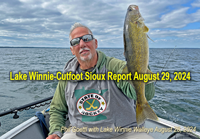 "The most recent heat wave, now passed, created a heavy algae bloom in Cutfoot and Little Cutfoot Sioux. Water clarity in the small lakes is low, we think somewhere in the 3-to-5-foot range. On Lake Winnie, the algae bloom is lighter, but still evident and water clarity out there ranges between 5 and 7 feet. The dingier water, combined with breezy conditions has made it easier for anglers to use traditional trolling and drifting presentations.
"The most recent heat wave, now passed, created a heavy algae bloom in Cutfoot and Little Cutfoot Sioux. Water clarity in the small lakes is low, we think somewhere in the 3-to-5-foot range. On Lake Winnie, the algae bloom is lighter, but still evident and water clarity out there ranges between 5 and 7 feet. The dingier water, combined with breezy conditions has made it easier for anglers to use traditional trolling and drifting presentations.
Within the past few days, there have been good reports from friends fishing on Lake Winnie using jig and minnow combinations, and there are still good reports from folks who prefer trolling the shorelines using spinners. Less common, but also being used by some, are shallow running crankbaits trolled across the flats. No matter which of these presentations you prefer, it is realistic to expect a mixed catch of pike, perch, and walleye, most likely in that order.
Key habitat varies somewhat from spot-to-spot but finding vegetation in water depths of 6 to 10 feet will get you in the ballpark. On breezy days, fish tend to rise above the tops, and out toward the clean edges of submerged grasses. On calmer, brighter days, they have trended toward heavier vegetation, and ..." Read >> Lake Winnie, Cutfoot Sioux Fishing Report August 29, 2024
More Recent Fishing Reports
Winnie 8-29 • Ely MN 8-28 • L.O.W 8-28 • MN DNR Workgroups • Sundin 8-26 • Winnibigoshish 8-24 • Sundin 8-22 • Grand Rapids 8-14 • Brainerd 8-13 • Sternberg 7-18 • Legal Bait Transport 6-1 • MN Record Fish • Barotrauma Study 1-25-24 • Fish Consumption • Forward Sonar • Panfish Workgroup • Follow on Facebook
 Ely Area, Arrowhead Outdoors Fishing Report August 28, 2024
Ely Area, Arrowhead Outdoors Fishing Report August 28, 2024
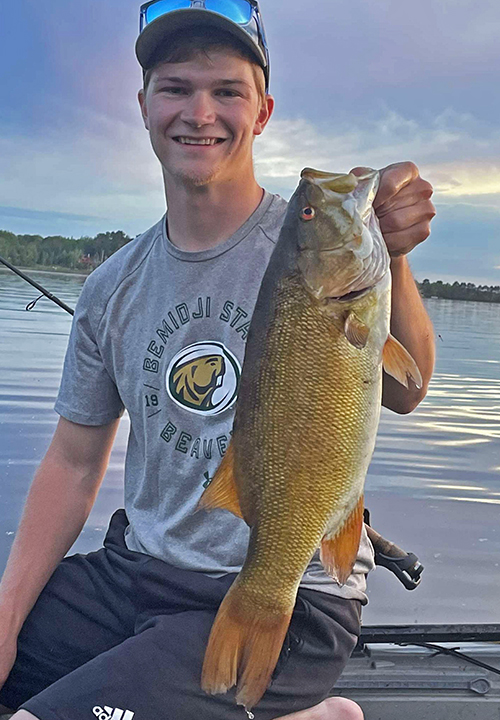 "Walleye - Stable weather has changed little with the walleye bite this last week. Shallow water walleyes continue to be found in the rocks and are hitting paddle tails on a 1/4 ounce jigs. Walleyes out on the sunken islands are still hitting orange or chartreuse colored spinner rigs, tipped with a leech or crawler and fished in 15 to 20 feet of water. Trolling continues to improve on many area lakes. Here anglers are trolling crankbaits over large flats in 15 to 30 feet of water.
"Walleye - Stable weather has changed little with the walleye bite this last week. Shallow water walleyes continue to be found in the rocks and are hitting paddle tails on a 1/4 ounce jigs. Walleyes out on the sunken islands are still hitting orange or chartreuse colored spinner rigs, tipped with a leech or crawler and fished in 15 to 20 feet of water. Trolling continues to improve on many area lakes. Here anglers are trolling crankbaits over large flats in 15 to 30 feet of water.
Smallmouth - Reports of great smallmouth fishing are coming from anglers looking for walleyes out on sunken islands. Here smallies have been hitting pike suckers fished on a jig, around sunken islands in 15 to 25 feet of water. Smallies continue to also hit topwater baits early in the mornings or on cloudy days. Paddle tails, spinnerbaits and wacky worms have been effective on those shoreline smallies. Anglers should be looking for large boulders, timber and points, in 10 feet of water or less.
Panfish - Crappie and bluegill bite has been hot on many Ely area lakes. Anglers have been finding the bluegills in a weedbeds and around down trees. Small angleworms or wax worms, fished under a bobber has been very effective. Crappies too have been using the weedbeds, but more often than not don't show up in the weedbeds until the evening hours when the gills slow down. Jig/twister, beetle spins and crappie minnow, under a bobber have all been effective on crappies.
Pike - Large pike have started to show up in many anglers catches this last week. Anglers have been catching pike while fishing medium to large suckers under a bobber, right off their docks. Anglers fishing from a boat have been casting or trolling large spoons and crankbaits along weedlines or mouths of shallow bays.
Stream Trout - Rainbow trout have remained active this last week for many anglers. Trolling cowbells, tipped with a small spoon or crankbait, over deep water, continues to be very effective. Anglers fishing from shore or off a dock have also been having good luck catching trout. Night crawlers fished 5 to 10 feet under a bobber have been the way to go.
Lake Trout - Laker reports have cooled off this last week, which isn't surprising considering how hot it was last week. Anglers continue to fish for them with down riggers and large trolling spoons along the thermocline in 40 to 60 feet of water. Anglers fishing from a canoe have been having some luck jigging large bucktails and heavy tube jigs over deep water." — Arrowhead Outdoors, 218-365-5358
 Wired2Fish August 28, 2024 "Have We Been Doing Catch and Release Wrong?"
Wired2Fish August 28, 2024 "Have We Been Doing Catch and Release Wrong?"
 "Catch and Release has been heralded as the saving grace of bass fishing in the modern era. While I don’t discount that statement as fisheries definitely can flourish if the good fish are left to reproduce and create more big fish. That’s certainly a good thing. And letting a good fish go, also gives another angler, and hopefully several other anglers, a chance to experience a similar rush in fishing. All good things related to catch and release.
"Catch and Release has been heralded as the saving grace of bass fishing in the modern era. While I don’t discount that statement as fisheries definitely can flourish if the good fish are left to reproduce and create more big fish. That’s certainly a good thing. And letting a good fish go, also gives another angler, and hopefully several other anglers, a chance to experience a similar rush in fishing. All good things related to catch and release.
I have also seen, however, where the catch and release proliferation goes off the rails. I have seen a good many stunted small fisheries, something that is not talked about nearly as much because there is this foreboding notion that if we keep bass we are destroying fisheries. Traveling and fishing has made me question whether our approach to catch and release has been handled wrong by us in some cases as an angling community. So I thought I’d ..." Learn More >> Have We Been Doing Catch and Release Wrong?
 Lake of the Woods, LOW Tourism August 28, 2024
Lake of the Woods, LOW Tourism August 28, 2024
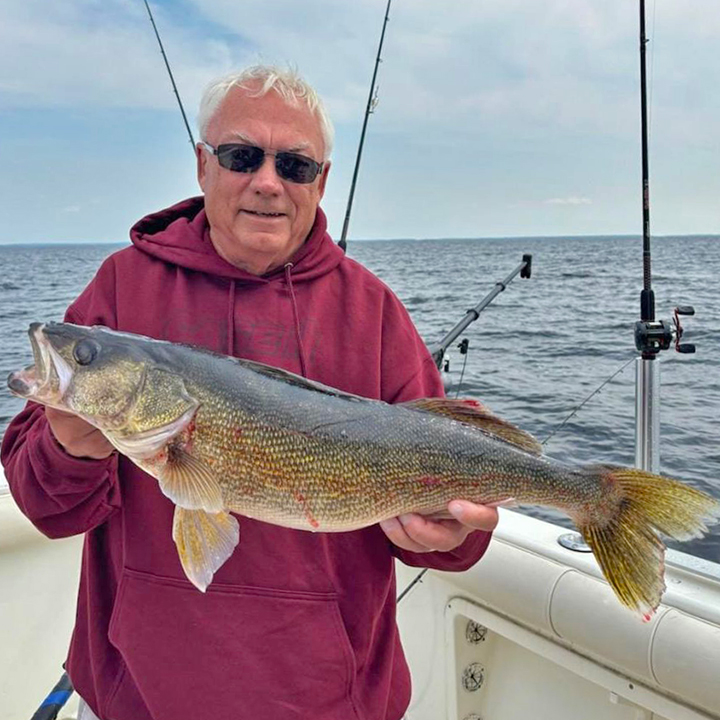 The excellent walleye and sauger bite continues across Lake of the Woods. On the south end, deep mud continues holding big numbers of fish. Walleye found in 30 to 35 feet of water is the norm right now for depth.
The excellent walleye and sauger bite continues across Lake of the Woods. On the south end, deep mud continues holding big numbers of fish. Walleye found in 30 to 35 feet of water is the norm right now for depth.
Anglers are catching fish using many different techniques. Pulling spinners, trolling crankbaits and jigging are all producing fish. A two hook crawler harness with a spinner blade colored in gold, gold/pink, pink, orange, glow red, glow white, or a combo of these colors. Use a 2 to 3 ounce weight to get it down. Heavier in deeper water and in breezy conditions.
Trolling crankbaits continues to catch good numbers of fish as well. When walleyes spread out over the miles and miles of mud over Big Traverse Bay, covering water is a good strategy.
Rock reefs, or the areas adjacent to the rock, are holding some nice walleyes and saugers. With miles and miles of open mud basin, areas of structure can be a magnet. Many anglers will jig on top of the rocks. Jigging has been successful over mud where there are numbers of fish.
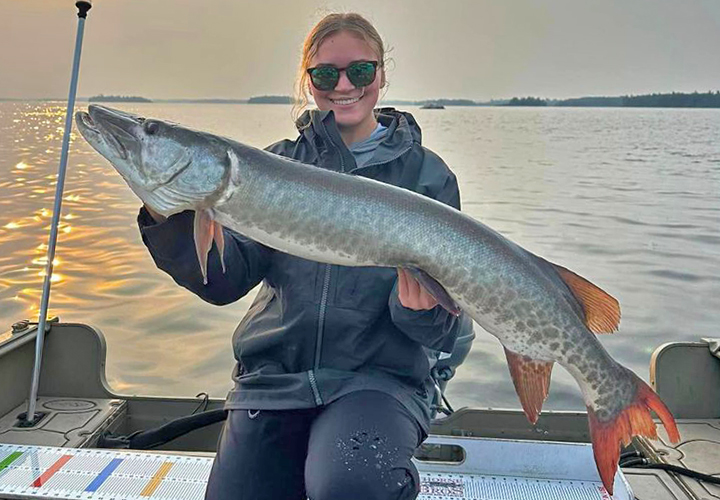 Anglers fishing tournaments are utilizing forward facing sonar and are sharp shooting big walleyes in all parts of the water column throughout Big Traverse Bay. The recent winners of the AIM Pro Walleye Minnesota Championship tournament put up 5 walleyes for over 50 pounds. This is the second tournament in a row that saw over a 10 pound per walleye average. These fish were caught, photographed and released.
Anglers fishing tournaments are utilizing forward facing sonar and are sharp shooting big walleyes in all parts of the water column throughout Big Traverse Bay. The recent winners of the AIM Pro Walleye Minnesota Championship tournament put up 5 walleyes for over 50 pounds. This is the second tournament in a row that saw over a 10 pound per walleye average. These fish were caught, photographed and released.
On the Rainy River, a variety of species of fish continue being caught. There is still some decent current which has drawn extra fish into the river.
Sturgeon anglers are reporting good summer action. Anchored up soaking some crawlers or frozen emerald shiners (or both) is the name of the game. There were some good reports from the river this week for walleyes and some nice sized fish as well. Reports of quite a few shiners in the river already. Shiners will often attract walleyes. Jigging, trolling spinners/crawlers or trolling crankbaits are all producing fish.
Excellent walleye fishing also continues in the Northwest Angle. Some fish are on the structure while others are hanging out over flats. Different forage in different areas these predators are focused on.
Mud from 15 to 30 feet such as east of Little Oak Island, near Four Blocks or north of Garden Island have been producing walleyes. When fish are sliding out to mud flats, spinners and crawlers which cover water work well, as do trolling crankbaits. In this part of the lake, it is often a mixed bag including walleyes and saugers, perch, crappies, pike, bass and even muskies. — Lake of the Woods Tourism, (800) 382-FISH
 August 27, 2024 "Joining the Join-Able: MN DNR Citzen Workgroups"
August 27, 2024 "Joining the Join-Able: MN DNR Citzen Workgroups"
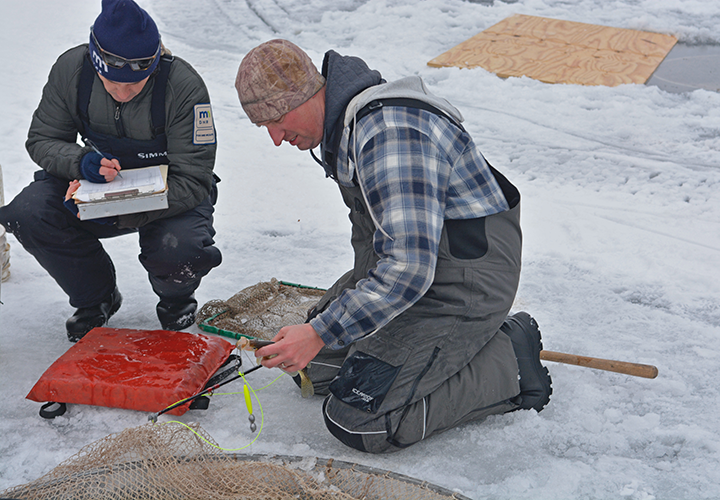 Some of you already know that I served as one of the charter members of the “Walleye Advisory Committee”, a group of citizens concerned about walleyes and walleye management in Minnesota. That project sought to allow ordinary folks access to decision makers within the DNR. Fisheries managers, fisheries biologists, field staff and others met regularly to discuss issues important to walleye anglers in Minnesota.
Some of you already know that I served as one of the charter members of the “Walleye Advisory Committee”, a group of citizens concerned about walleyes and walleye management in Minnesota. That project sought to allow ordinary folks access to decision makers within the DNR. Fisheries managers, fisheries biologists, field staff and others met regularly to discuss issues important to walleye anglers in Minnesota.
Seeing value in the walleye project, MN DNR set about the formation of more citizen volunteer panels known today as “Fisheries Work Groups”. These days, I serve as a volunteer on Minnesota DNR’s Panfish Workgroup. Other workgroups include bass, catfish, musky and the newest one, “The Technology Workgroup” on which I also serve.
Occasionally, I hear from folks asking various questions about fisheries management in Minnesota. Whenever I do, I give then the best answer I can, but also routinely advise them to get involved and learn more by joining one of these workgroups. After almost 20 years of volunteering, I HAVE LEARNED SO MUCH! I simply can’t imagine not continuing to be involve with one of these workgroups, and whenever my time expires on the panfish group, I definitely will apply to serve on another one.
Today, the DNR announced that they are actively seeking new members for many of the citizen volunteer groups. So, this is your chance to get involved, voice your concerns and influence the system. Follow the news release below for more information about the groups, and learn ho to apply. ![]() — Jeff Sundin • The Early Bird Fishing Guide • Office Cell Call or Text 218-245-9858 or Email
— Jeff Sundin • The Early Bird Fishing Guide • Office Cell Call or Text 218-245-9858 or Email
 News Release August 27, 2024: "Minnesota DNR seeks applications for advisory groups"
News Release August 27, 2024: "Minnesota DNR seeks applications for advisory groups"
"The Minnesota Department of Natural Resources is recruiting new members to serve on key advisory groups related to fish and wildlife conservation; promoting knowledge and skills in fishing, hunting, trapping and related activities; conservation policy and funding; parks and trails; and aquatic invasive species. Interested people can learn more or apply on the Engage with DNR webpage (engage.dnr.state.mn.us/advisory-group-appointment-opportunities).
Advisory groups are one way the DNR works with Minnesotans to further the department's mission. Participation in one of these appointed roles is an important way that Minnesotans can contribute their ideas and perspectives.
Most terms begin in 2025 and are for three years, and most groups meet four to six times per year, with in-person and online options for joining meetings. Exceptions to this pattern are noted below where applicable.
The Minnesota DNR strives for each committee to include people from a diverse mix of backgrounds, perspectives, locations and experiences, so that we can benefit from the breadth of knowledge and insight that such diversity brings and so that our advisory committees reflect the population of Minnesota.
Fisheries Work Groups
Fisheries work groups provide input and feedback on DNR policies related to bass, northern pike and muskie, panfish, walleye, and commercial production of minnows. Members represent a variety of viewpoints and work together to address topics such as recreation, water quality, fish habitat, fish management and effects on local economies.
The commercial minnow work group is a new advisory group created to enhance dialogue between the DNR and commercial minnow interests to discuss research, population, harvest trends and fisheries management in Minnesota.
Online applications (engage.dnr.state.mn.us/embeds/projects/7945/survey-tools/22952) will be accepted until 4:30 p.m. Friday, Sept. 27. More information about fisheries work groups is available on the DNR website (mndnr.gov/fishgroups).
Hunter and Angler Recruitment, Retention and Reactivation Council (R3 Council)
The Minnesota R3 Council works with and is facilitated by the DNR to develop a plan and implement strategies to promote knowledge, skills and participation in hunting, fishing and closely related outdoor activities. Members work to educate the public and make it easier to get involved in hunting, fishing, and related outdoor recreation. The group makes recommendations for recruiting new, retaining current and reactivating former hunters and anglers in Minnesota.
Online applications (engage.dnr.state.mn.us/embeds/projects/7945/survey-tools/22952) will be accepted until 4:30 p.m. Friday, Sept. 27. More information about the R3 Council is available on the DNR website (mndnr.gov/r3/council).
Mille Lacs Fisheries Advisory Committee (MLFAC)
This group makes recommendations to the DNR on fisheries management for Mille Lacs Lake. Members include representatives of area resorts, fishing guides and other businesses; property owners; county officials; representatives of the DNR’s work groups that focus on walleye, bass, and northern pike and muskellunge; and others.
The DNR supports the committee’s efforts by supplying information that is used to help manage the Mille Lacs fisheries, including standard fish population assessments, creel harvest surveys, status of invasive species and other available information requested by the committee.
Online applications (engage.dnr.state.mn.us/embeds/projects/7945/survey-tools/22952) will be accepted until 4:30 p.m. Friday, Sept. 27. More information about the MLFAC is available on the DNR website (mndnr.gov/millelacslake/advisory-committee.html).
Minnesota Parks and Trails Legacy Advisory Committee
People with enthusiasm for Minnesota parks and trails can help guide efforts to provide welcoming, engaging, accessible, rewarding and sustainable outdoor recreation experiences for everyone. The partner agencies of the Parks and Trails Legacy Advisory Committee include the Metropolitan Council, the Greater Minnesota Regional Parks and Trails Commission and the Minnesota Department of Natural Resources. The Parks and Trails Legacy Advisory Committee’s mission is to champion the 25-year Parks and Trails Legacy Plan.
Terms are two years, with the option of being reappointed for a maximum of three terms. The committee meets every two months at park and trail facilities around the state, with an online meeting option. Meetings typically include tours of state and regional parks and trails and provide members with the opportunities to experience the impact of projects and programs supported by the Parks and Trails Legacy Fund.
Online applications (legacy.mn.gov/ptlac/application) will be accepted until 4:30 p.m. Friday, Sept. 27. More details are available on the DNR website (legacy.mn.gov/ptlac).
Aquatic Invasive Species Advisory Committee
Aquatic invasive species present one of the state’s most pressing natural resource issues. Preventing the spread of zebra mussels, Eurasian watermilfoil, invasive carp, starry stonewort and other invasive plants and animals is critically important to Minnesota’s environment, recreation opportunities, and economy.
The Aquatic Invasive Species Advisory Committee comprises 15 members who provide advice and diverse perspectives on programmatic direction, emerging research needs, communications, and funding strategies. Members have a variety of personal and professional experiences with aquatic invasive species issues and represent a range of private, nonprofit and public sector organizations that are actively engaged in aquatic invasive species prevention.
Online applications (tinyurl.com/AISAdvisory) will be accepted until 4:30 p.m. Friday, Sept. 27. Interested applicants can learn more about the committee on the DNR website (mndnr.gov/aisadvisory).
Natural Heritage Advisory Committee
The Natural Heritage Advisory Committee advises the DNR on issues relating to sustaining the state’s natural heritage, biological diversity and ecosystem services. NHAC members make recommendations to help protect high quality prairies, forests, wetlands and other native habitats, and the diversity of plants and animals they support.
NHAC applicants should have knowledge, demonstrated dedication or experience related to natural resource management, conservation biology, ecological education and outreach, and other aspects of Minnesota’s natural heritage.
New member appointments will begin in January 2025 and extend through December 2027. Minnesota residents with interest or expertise in sustaining our state’s natural heritage can apply online until 4:30 p.m. Friday, Sept. 27. Interested applicants can learn more on the DNR website (mndnr.gov/nhac).
Fish and Wildlife Advisory Committee
A newly created Fish and Wildlife Advisory Committee is taking the place of citizen oversight committees that operated from 1994 to 2024. The committee will review annual outcomes achieved from game and fish fund expenditures and make recommendations to the legislature and the commissioner for desired outcomes related to protecting, restoring, and enhancing fish and wildlife habitat; fish and wildlife population management; fish and wildlife monitoring and research; communications and engagement; and improvements in the management and use of money in the game and fish fund.
Nearly $100 million is expended from the Game and Fish Fund each year. The revenue supporting these expenditures is primarily the product of hunting and fishing license sales, federal reimbursements, and a sales tax on state lottery tickets.
Minnesota residents with a hunting, fishing or trapping license or an active critical habitat license plate can apply online until 4:30 p.m. Friday, Sept. 27. Interested applicants can learn more by visiting the committee page of the DNR website (mndnr.gov/gamefishoversight)."
 August 26, 2024 "Winnie Walleye Update"
August 26, 2024 "Winnie Walleye Update"
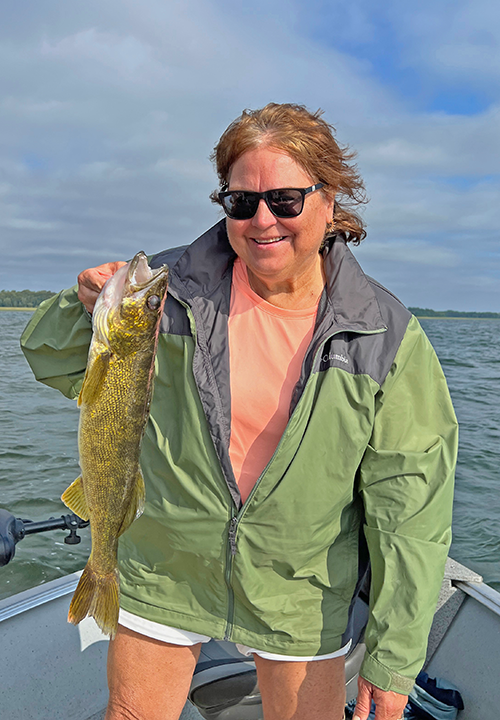 Early Saturday morning (8-24), I ended my report about Lake Winnibigoshish saying, “I’ve said before that if you can catch fish under tough conditions, then there’s probably a good underlying opportunity waiting to emerge… I think it’s a good bet that the next time conditions turn favorable, we’ll see another uptick in the shallow water action too.”
Early Saturday morning (8-24), I ended my report about Lake Winnibigoshish saying, “I’ve said before that if you can catch fish under tough conditions, then there’s probably a good underlying opportunity waiting to emerge… I think it’s a good bet that the next time conditions turn favorable, we’ll see another uptick in the shallow water action too.”
Little did I know that the opportunity to either prove or disprove that prediction would come about within a few hours of that report. That’s right, later that same day, the wind picked up, gusting in from the southeast at 10 to 15 MPH. Shortly afterward, the whitecaps started churning, the current began to flow, and walleyes went on the prowl in the shallows. It only took a couple of hours to come within a single fish of the filling limits for my crew on a spur of the moment, quick trip to Winnie’s west side.
Making that prediction wasn’t all that hard. That’s because almost always, the last half of August features increased walleye activity on the shoreline breaks, and shallow flats. So, after the uptick on Saturday, I was hopeful that on Sunday, under the same windy conditions, Winnie walleyes would treat my next crew, the Klapmeir’s, to another action-packed day. Somehow though, after that one-day concentration of feeding walleyes, the fish reverted to their previous pattern.
Instead of an easy day chasing walleyes concentrated in a single spot like they were on Saturday afternoon, Sunday’s trip turned into another geography quiz. For me, the test was to see how many spots I could think of, and get to, within the constraints of time. Fish were biting, and we caught a little something almost everywhere we stopped. The problem was we found singles, doubles and occasionally, small, single-digit groups of fish scattered across the flats and shallow breaklines. It took a long time to fish in each spot, so the catch rate wasn’t as impressive as the previous day.
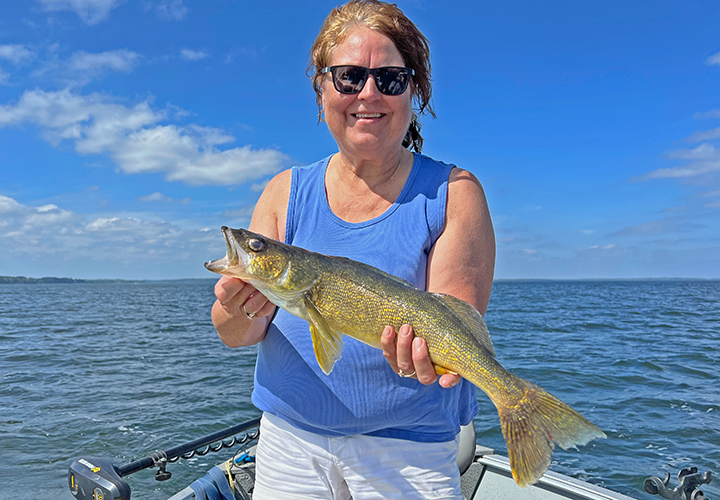 Suzy, pictured here, was not disappointed with her performance. She had a knack for catching larger protected slot fish. On this day, there were actually more of those than there were “keepers”, but we did harvest enough for a few meals.
Suzy, pictured here, was not disappointed with her performance. She had a knack for catching larger protected slot fish. On this day, there were actually more of those than there were “keepers”, but we did harvest enough for a few meals.
Except for one spot, all the fish we caught were located in water depths of 6 to 8 feet. The exception was a sloping, 11-foot-deep point, surrounded by water in the 12-to-14-foot range. The presence of weeds was helpful, but in the whitecaps, fish were not holding very tight to the vegetation. We were able to keep our spinners above the weed tops, moving at 1.1 to 1.3 MPH.
Perch were more plentiful than they had been on recent outing, but few of them fell within keeper range. Most were 6 to 9 inches long, a few ranged from 10 to 12 inches, so we added those to help round out the harvest. Northern pike were few and far between, and they were small; we did not harvest any of them, although if the opportunity had presented itself, we would have.
We’ve heard a lot about the two 2018- and 2019-year classes of walleyes. Until recently, there hasn’t been much news about whether there are any more good year classes in the pipeline. Yesterday, we caught some small fish ranging between 10 and 13 inches. Last week, I talked with a friend who told me that he’s been catching a lot of smaller size fish lately.
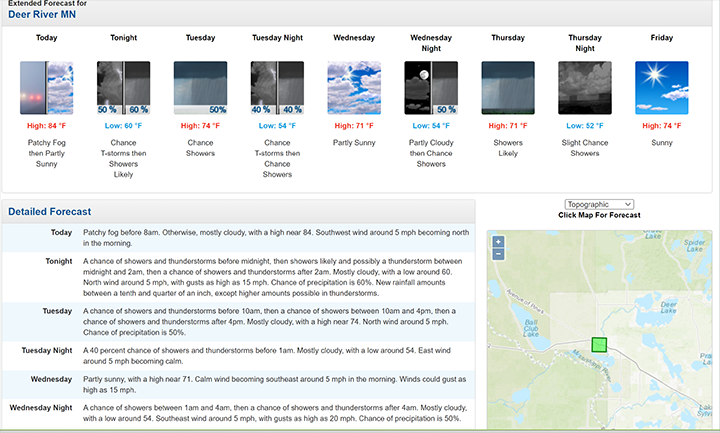 So, don’t take it as gospel, but it does appear that there is at least another “decent” year class of fish coming along. That would be good news for folks who like to catch “eater size” fish because now, many of the 2018 fish are already in the 18-to-23-inch protected slot. Soon, some of the 2019 fish will begin reaching that size too and by next year, lots more of them will reach the protected slot size category.
So, don’t take it as gospel, but it does appear that there is at least another “decent” year class of fish coming along. That would be good news for folks who like to catch “eater size” fish because now, many of the 2018 fish are already in the 18-to-23-inch protected slot. Soon, some of the 2019 fish will begin reaching that size too and by next year, lots more of them will reach the protected slot size category.
Despite warm air temperatures and sunny skies, the surface water readings on Winnie hovered around 72 degrees on Sunday. With all the wind, water in the shallows is mixed thoroughly and, in many areas, the water temperatures vary little from top to bottom. I’m looking forward to “the jigging season”, but most folks like the simplicity of trolling with spinners, so it’s likely that this will be my main presentation for the rest of this week.
I’m cautious about basing fishing predictions on the weather forecast. That said, it appears that we are headed into a period that’s very typical of most late August, Labor Day fishing patterns. The extended forecast for Deer River suggests a week of southerly winds, grey skies, moderating temperatures and mixed precipitation. This, if it happens, is a solid recipe for increasing shallow water walleye activity. Mid-lake bars, especially the largest ones, also “get good” during this late summer pattern. So, I’m optimistic that we have a good week ahead of us; we’ll know soon enough. ![]() — Jeff Sundin • The Early Bird Fishing Guide • Office Cell Call or Text 218-245-9858 or Email
— Jeff Sundin • The Early Bird Fishing Guide • Office Cell Call or Text 218-245-9858 or Email
 August 24, 2024 "Lake Winnie Tough, But Not Impossible"
August 24, 2024 "Lake Winnie Tough, But Not Impossible"
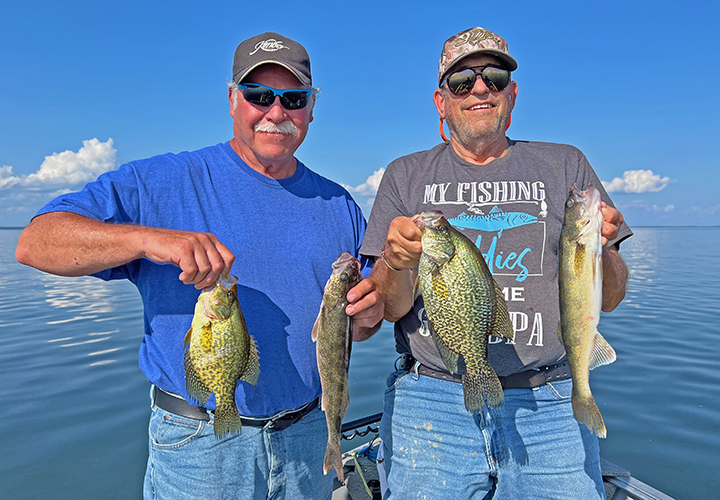 If your baseline is perfection, and catching easy limits of walleye is your only happy outcome, then on certain days, Winnie will disappoint right now. If, on the other hand, spending a nice day on the lake, catching some of everything and returning to the dock with a few meals worth of fish suits you, then I'm pretty sure you’ll be happy.
If your baseline is perfection, and catching easy limits of walleye is your only happy outcome, then on certain days, Winnie will disappoint right now. If, on the other hand, spending a nice day on the lake, catching some of everything and returning to the dock with a few meals worth of fish suits you, then I'm pretty sure you’ll be happy.
The good news is that warm, 74-degree surface temperatures and sunshine have created a healthy algae bloom on the lake. Water clarity on Friday was something like 6 or 7 feet in the areas we fished. Weed growth, where you can find it, is healthy and green too. So, the dingier water, combined with improved vegetation has encouraged fish to move shallower. Fish can now be found on all 4 sides of the lake, in water depths of 6 to 12 feet. Warm water temperatures also keep fish metabolism high, making trolling presentations more effective.
The bad news is that all the extra habitat is making it easier for fish to spread out horizontally. Chasing small, scattered schools of fish on Friday meant that we had to make a lot of moves, cover and lot of territory and settle for short spurts of action, rather than extended periods of action. It was common for us to troll along a weed edge, catch a handful of mixed fish on the first pass, then catch less, or none, on the next trolling pass. If you encounter calm, bright conditions, then covering water, and trying lots of spots will likely be called for.
For me and my crew, Jeff and Manny, trolling spinners was the only presentation we used. The standard, single hook, #3 Hammered Gold Indiana Blade behind a 3/16 ounce bullet sinker worked fine. Tipping the hooks with leeches seemed at one time to be better than using minnows. But there was a period when minnows seemed better too, so I’d experiment with both. It may have been a one-day thing, but for me, night crawlers were ineffective on this trip. I don’t recall catching anything when I used them.
There was one time when we passed by a single isolated patch of cabbage weeds that housed a few crappies. On that spot, we caught a total of 5, but might have been better off stopping and casting small jigs and plastics. At the time, we were content with pursuing the “mixed bag” and didn’t test the theory.
The reason I brought it up is that this small patch of cabbage was the only place we ever caught any crappies yesterday. So, I don’t want to give you the impression that they were widespread, or that all you have to do is start trolling the weeds and you’ll find crappies. Over the past few years, this has happened to me a few times and when it does, it seldom repeats. We just have to be happy with the ones and wait until the next lucky break comes along.
Late in the day, I tested another late summer pattern, fishing on gravel patches on mid-depth flats. To an extent, it worked, there were 3 or 4 spots where we picked up a single fish. Either there wasn’t a lot of fish on the flats, or the calm sunny water discouraged them from being active. Either way, it might be a handy trick to have in your back pocket if you need to pick up a few fish in an emergency.
The key is to locate small rock/gravel rises that top out at depths of about 11 to 13 feet. They’re usually surrounded by water ranging in depths of 14 to 16 feet. The easiest way to find them is by using side-imaging, that method easily reveals the gravel patches. Over the years though, many of the ones I found were noticed on my sonar as I moved from spot-to-spot. So, if you notice a bump on the flats, mark the spot and check it out.
The headline, "Tough But Not Impossible" might not be the best way to characterize our fishing trip on Friday. Hot bite or not, it wasn’t a bad day at all, we brought in enough fish for a few meals and luckily for me, Jeff and Manny are copesetic people. They enjoyed the nice weather, were satisfied with the fish we caught and kept the mood cheerful right up to the end of the day. How can you beat that?
I’ve said before that if you can catch fish under tough conditions, then there’s probably a good underlying opportunity waiting to emerge. And I think yesterday provided an example of that. With flat water and sunny skies, we didn’t have a hot bite, but there were enough fish biting to make it interesting. Last week, when the wind blew, and the sky darkened, there were some very good reports from folks who fished in the shallow water. I think it’s a good bet that the next time conditions turn favorable, we’ll see another uptick in the shallow water action too. ![]() — Office Cell Call or Text 218-245-9858 or Email
— Office Cell Call or Text 218-245-9858 or Email
 August 22, 2024 "Adapting to the Adapt-Able"
August 22, 2024 "Adapting to the Adapt-Able"
 Presentation is a term that gets thrown around a lot in fishing articles and the like. If there’s a fish you want to catch, there’s a “big time pro” who’s put out a video explaining the best presentation for making it bite. Almost all of the tutorials are correct, provided we figure out the proper time and place to use them. Sometimes, we learn how to catch fish in a certain way, then become overly reliant on that presentation. We sometimes stick with the ones we love and miss out on a presentation that would have worked better, under a particular set of circumstances.
Presentation is a term that gets thrown around a lot in fishing articles and the like. If there’s a fish you want to catch, there’s a “big time pro” who’s put out a video explaining the best presentation for making it bite. Almost all of the tutorials are correct, provided we figure out the proper time and place to use them. Sometimes, we learn how to catch fish in a certain way, then become overly reliant on that presentation. We sometimes stick with the ones we love and miss out on a presentation that would have worked better, under a particular set of circumstances.
On Wednesday, I experienced a situation where different species of fish, all located in the same spots, at the same time, showed preferences for different presentations. For me, it was a glaring example of how easy it can be to miss out on great fishing action by relying too much on any one favorite presentation and not working at adapting to habitat and weather situations.
Before I go further, let me set up how the situation evolved.
My crew, Don and his grandson Kade had already fished with me last Monday and we had a decent day catching crappies. That day, we trolled spinners and didn’t do much of anything else. During the trip, I learned that Kade loved to cast, and that he had some favorite lures that he liked to use. So, in my mind, an ideal scenario for our Wednesday trip would be fishing on a lake that offered an opportunity for him to do that. The lake I selected has a variety of fish but the ones I had in mind for Kade were largemouth bass and northern pike.
It seemed like a routine start, to a routine day when we arrived at the landing. We loaded up all the fishing gear and made the boat ready for fishing. Then I jumped in the truck to back the boat into the water and learned that the transmission would not shift into reverse, or forward, or any other gear. Eventually, our friend Joe Nelson, from Joe’s Garage in Grand Rapids helped diagnose the trouble. But before I could do anything about it, I would need to be rescued by the Hippie Chick. She drove her truck to the landing, so we could get the trip started. But now, she’d either have to hang out with us, or limp back to town in a semi-broken vehicle; the decision was that she’d hang with us. That changed the game the original plan a little bit, but also offered an opportunity to experiment.
 Luckily for me, there was a good wind, and I was able to set up a pattern for drifting with Kade in front, casting toward the shallow weeds. Don in the next seat, fishing the inside edges of the deeper weeds, and the Hippie Chick and I fishing the deeper, outside weed edges. We were all using different presentations, Kade was casting stick baits like his favored black/gold Husky Jerk. Don was using a 1/8-ounce Lindy Jig tipped with a white pearl, 3-inch Ripple Shad. Susan was wiggle worming with a 1/16 Live Bait jig and live night crawler. I was trying anything that came to mind.
Luckily for me, there was a good wind, and I was able to set up a pattern for drifting with Kade in front, casting toward the shallow weeds. Don in the next seat, fishing the inside edges of the deeper weeds, and the Hippie Chick and I fishing the deeper, outside weed edges. We were all using different presentations, Kade was casting stick baits like his favored black/gold Husky Jerk. Don was using a 1/8-ounce Lindy Jig tipped with a white pearl, 3-inch Ripple Shad. Susan was wiggle worming with a 1/16 Live Bait jig and live night crawler. I was trying anything that came to mind.
On that drift, Don was having the best action, largemouth bass loved that white ripple shad, and he was in the sweet spot for catching them, just inside the weed edges in about 12 feet of water. Susan’s wiggle worm was getting struck, but not by walleyes; she caught some bass on it, and there were panfish snacking the crawlers too. Kade’s stick baits were not setting the world on fire, but he did get a couple of pike, and a bass or two as well. On a drop shot and leech combo, I caught several sunfish. Then switched to a heavier, 3/8-ounce jig with a larger, 3-1/2 inch Ripple Shad. Jigging aggressively along the outside of deep weeds caught me a nice pike, and a larger bass too.
Still looking for a walleye, or maybe a crappie, I moved to a fresh spot, another weedline, this time on the breezy side of the lake. Here though, the wind actually worked against the plan. With the stern facing into the wind, forcing a drift by using the outboard, we were moving too slow. Unless we were ready to abandon casting and start trolling, we’d have to make another move.
The next stop, a mid-lake weed bar had fish on it too and among them, a school of sunfish. The casting and drifting worked fine, but needing fish for the upcoming family fish fry, we decided to stop there and single out some of those sunfish. We hovered, dropped 1/8-ounce jigs tipped with chunks of night crawlers over the side, and caught sunfish. A couple of bass, a crappie and even a pike or two snapped up the little morsels of food too.
We’d been fishing for a while now, and we’d have pretty good action. The problem was that most everything we did was working better than casting the stick baits, I guess I was tired of watching Kade not being the one catching more fish and decided to pull out the spinner rods and start trolling. We moved back to the shoreline, picked up the weedline in about 12 feet of water and threw in the spinners, tipped with fatheads. Now we started catching crappies, perch and even a couple of small walleyes. Nothing about the habitat was different, the only change was our presentation.
Admittedly, not every lake is going to offer up such clear-cut examples of how varying presentations help us target specific species from an area where species are mixed. It is something to think about if you find yourself in a similar situation.
To a lesser extent, we faced a similar test of adaptability on Winnie this Tuesday. I was chasing my own tail moving from spot-to-spot and trying to get walleyes by pinning down singles and doubles on mid-lake structure. By early afternoon it was clear that something needed to change. So, I explained to the crew we were going to change our approach. “No more running all over the lake chasing other people’s old reports. We’re going to move into the shallows, put out the spinners and start trolling until we find something”, I advised.
I’m not going to try to convince you that this was a brilliant decision, but it was better than what we’d been doing. Sticking with the weed edges in 6 to 8 feet of water, we picked up 5 decent walleyes, a few keeper perch and even 3 crappies. For a fishing guide, that’s not a great trip, but if I was on the lake, fishing with my family, we’d have been thrilled with what we’d caught that day.
Adaptability, the general theme of today’s report, is about more than just figuring out how to catch more fish. It’s also got a lot to do with figuring out how to be happy accepting what the lake is willing to give us. I’ve spent the past few days fishing with folks who have more than tolerated changing situations, they’ve embraced them. The term “going with the flow” comes to mind, it’s been the secret to seeing happy faces in my boat, that’s for sure. ![]() — Office Cell Call or Text 218-245-9858 or Email
— Office Cell Call or Text 218-245-9858 or Email
 Wired2Fish August 21, 2024 "Jacob Wheeler’s Guide to Fishing the Thermocline"
Wired2Fish August 21, 2024 "Jacob Wheeler’s Guide to Fishing the Thermocline"
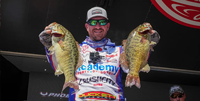 "When Jacob Wheeler was just a teenager, he learned an important lesson about summer fishing. A mentor taught him about how the lakes would stratify in the dog days of July, August and September. The top layer had the most oxygen but highest water temperatures. The lower layer had cooler water temperatures but virtually no oxygen—and very little life. Just above a magic layer that separated those two zones – a narrow band called the thermocline – was the place to fish.
"When Jacob Wheeler was just a teenager, he learned an important lesson about summer fishing. A mentor taught him about how the lakes would stratify in the dog days of July, August and September. The top layer had the most oxygen but highest water temperatures. The lower layer had cooler water temperatures but virtually no oxygen—and very little life. Just above a magic layer that separated those two zones – a narrow band called the thermocline – was the place to fish.
“He would idle around until he found that fuzzy layer with his electronics and he knew where to fish,” said Wheeler who recently won Angler of the Year honors for the third time on the Major League Fishing Bass Pro Tour. “If he found the thermocline at 15 feet, he would say, ‘We’re not fishing anything ..." Learn More >> Jacob Wheeler’s Guide to Fishing the Thermocline
 Ely Area, Arrowhead Outdoors Fishing Report August 21, 2024
Ely Area, Arrowhead Outdoors Fishing Report August 21, 2024
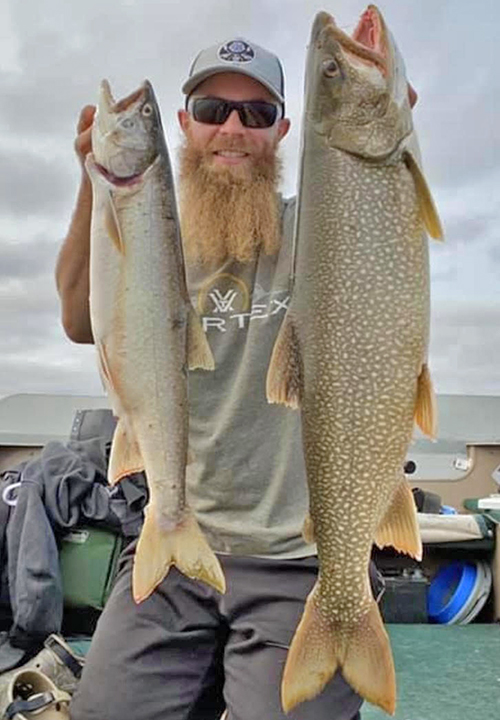 "Lake trout reports slowed up this last week. Covering ground, looking for active biters has been the key to catching lakers. Trolling with downriggers, along the thermocline, has been the way to go to catch trout. 40 to 60 feet of water remains the depth to look for lake trout.
"Lake trout reports slowed up this last week. Covering ground, looking for active biters has been the key to catching lakers. Trolling with downriggers, along the thermocline, has been the way to go to catch trout. 40 to 60 feet of water remains the depth to look for lake trout.
Stable weather has improved the walleye bite on many Ely area lakes. Shallow water bite has returned on many area lakes also. Anglers fishing this bite have been catching walleyes in 6 to 10 feet of water. Here paddle tails remain very popular and effective. Slip bobber and a leech, during the evening hours, in weedbeds or weedlines. Spinner rigs, tipped with a crawler, have remained very effective out on sunken islands. Pike suckers tipped on a 1/4 or 3/8 ounce jig is also worth noting out here. Out here anglers are working the edges of the structure in 15 to 25 feet of water. The trolling bite also remains very strong. Here anglers are trolling crankbaits in 15 to 20 feet of water, over large flats. Hot colors continue to be orange, chartreuse, gumball and gold.
Smallmouth - Smallies continue to hit topwater early in the mornings or all day on cloudy days. Here anglers have been working shoreline structures like large boulders, timber and boulder flats. Once the sun gets up the big smallies slide out to sunken islands. Here anglers have been catching big smallies with small sucker minnows and soft plastics.
Panfish - Crappies and sunnies are both being found in and around weedbeds. Anglers continue to catch crappies just off the weedbeds during the day and inside the weedbeds during the evening hours. Beetle spins and jig/twister tails also remain very effective here. Sunnies have slid back into the shallow weedbeds and shoreline timber. Here, small angleworms, leech or wax worms, fished under a bobber have been very effective on big bluegills.
Stream Trout - Rainbow trout have been active this last week for shore anglers. These anglers have been fishing a night crawler, 5 to 10 feet under a bobber during the evening hours. Anglers fishing from a boat, continue to troll cowbells with small crankbaits or spinner rigs, tipped with a crawler, over deep water.
Pike - Some big pike were reported this last week from many anglers targeting them. Medium to large suckers, fished under a large bobber accounted for the majority of them caught. Large topwater lures, large crankbaits and large spoons, fished at the mouth of shallow bays, river mouths and weedlines also accounted for their fair share of pike caught." — Arrowhead Outdoors, 218-365-5358
 Wired2Fish August 2024 Topwater Tips for Smallmouth Bass in Calm Water
Wired2Fish August 2024 Topwater Tips for Smallmouth Bass in Calm Water
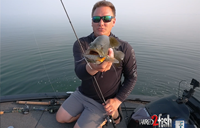 "Summer smallmouth bass are a sucker for topwater lures. Wired2fish’s Kyle Peterson hits famed Mille Lacs Lake on one of those rare calm days, and the smallmouth were on the topwater chew! He shares his two favorite topwater lure categories for targeting smallmouth, when he uses each and how to fish them, and how to find high-percentage locations for targeting topwater-tuned smallies. Check out our Topwater Tips page for more in-depth content.
"Summer smallmouth bass are a sucker for topwater lures. Wired2fish’s Kyle Peterson hits famed Mille Lacs Lake on one of those rare calm days, and the smallmouth were on the topwater chew! He shares his two favorite topwater lure categories for targeting smallmouth, when he uses each and how to fish them, and how to find high-percentage locations for targeting topwater-tuned smallies. Check out our Topwater Tips page for more in-depth content.
UNVEILING THE TOPWATER BASS FISHING STRATEGY: Peterson starts by highlighting the importance of observing surface conditions. On this particular outing, the calm water made it easy to spot surface-feeding smallmouth keyed on small baitfish. The same situation occurs during ..." View Video and Learn More >> Topwater Tips for Smallmouth Bass in Calm Water
 Lake of the Woods, LOW Tourism August 21, 2024
Lake of the Woods, LOW Tourism August 21, 2024
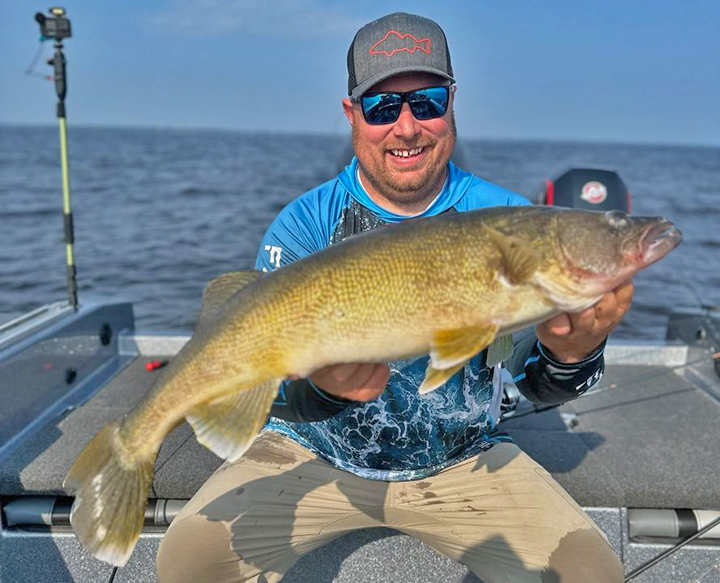 " The "dog days of summer" are some of the best days of the fishing season on Lake of the Woods. There is some excellent walleye fishing taking place on the south side of Lake of the Woods right now. Not only for eater size fish, but with some huge walleyes being caught as well.
" The "dog days of summer" are some of the best days of the fishing season on Lake of the Woods. There is some excellent walleye fishing taking place on the south side of Lake of the Woods right now. Not only for eater size fish, but with some huge walleyes being caught as well.
The deep mud bite is in 28 to 35 feet of water. Anglers are catching good numbers of fish on the mud using mainly two different techniques, spinners and crankbaits.
Most anglers are getting their walleyes with spinners and crawlers. A two hook crawler harness with a spinner blade colored in gold, gold / pink, pink, orange, glow red, glow white, or a combo of these colors. Drift or troll at 1 - 1.25 mph with a 2 - 3 ounce weight or bottom bouncer and two hook harness with a crawler. A 3 ounce bouncer is very helpful in depths over 30 feet.
Trolling crankbaits continues to catch a lot of fish as well. With so many walleyes spread out over the miles and miles of mud over Big Traverse Bay, covering water is a good strategy.
Some walleyes are also hanging out on, or adjacent to, rock reefs. With miles and miles of open mud basin, areas of structure can be a magnet. Anglers utilizing forward facing sonar are sharp shooting big walleyes in all parts of the water column throughout Big Traverse Bay. The recent winners of the David A. Andersen Warrior Boats tournament put up 5 walleyes for 55.76 lbs.
On the Rainy River, there are a variety of species of fish continue being caught. Sturgeon anglers are reporting consistent summer action. Anchored up in a hole of the river or the sloping bank from the hole to a flat and soak some crawlers or frozen emerald shiners (or both). Walleye anglers are finding walleyes on flats, in holes, current breaks and over rocky areas. Jigging, trolling spinners / crawlers or trolling crankbaits are all producing fish.
Up at the Northwest Angle. excellent walleye fishing continues. Points, sunken islands, saddles, and neck down areas with current are just a few ideas. Deep mud such as east of Little Oak Island or north of Garden Island have been producing walleyes. When fish are sliding out to mud flats, spinners and crawlers which cover water work well, as do trolling crankbaits. Muskie anglers are finding fish, but report it has not been what they call a normal year. Fish are being found in a variety of areas. A mixed bag includes walleyes and saugers, perch, crappies, pike, bass and even muskies." — Lake of the Woods Tourism, (800) 382-FISH
 August 20, 2024 "Welcome Back Summer"
August 20, 2024 "Welcome Back Summer"
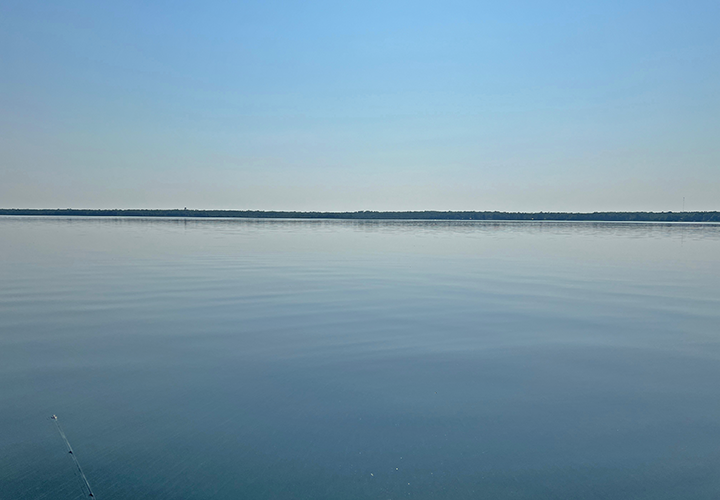 Summer sunshine is back, and surface water temperatures have risen; now hovering around 75 degrees. The warmer water triggered increased activity of bass and sunfish, crappie action has hung in there too, but without a breeze to work with, walleyes have been tricky to coax during the daytime. Despite what appears to be a tough fishing period ahead, I’m optimistic. Looking at the forecast, I see more wind predicted, and I can’t help but believe that a chop on the water will help, maybe a lot.
Summer sunshine is back, and surface water temperatures have risen; now hovering around 75 degrees. The warmer water triggered increased activity of bass and sunfish, crappie action has hung in there too, but without a breeze to work with, walleyes have been tricky to coax during the daytime. Despite what appears to be a tough fishing period ahead, I’m optimistic. Looking at the forecast, I see more wind predicted, and I can’t help but believe that a chop on the water will help, maybe a lot.
Last week, while I was at the clinic getting my finger looked after, reports from friends were generally good. Both Cutfoot Sioux and Winnie were kicking out good numbers of panfish and walleye reports, while not great, were still good enough to keep most folks happy. During that time, there were not only heavier winds, but the sky was darker too. Reports from some of those same friends were not as good yesterday, sunshine and calm water slowed the action down a lot.
For me, grinding away in the weeds, trolling spinners has been moderately effective. Crappies have moved back into some of the heavier patches of vegetation, not cabbage so much, but the denser, and deeper mats of coontail and other pondweeds. On Monday, we found fish in what I believe was flat stemmed pondweed, you should get to know this one because it’s a plant that commonly attracts crappies. It was growing at the outer edges of the weedy flats in water depths of 9 to 11 feet and whenever I could find patches of it, there were at least some crappies in them. On Sunday, at a different Bemidji area lake, there were crappies in the exact same type of habitat.
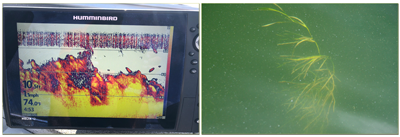 During late summer, these weeds will look like bushy patches on your graph. If you imagine the large round tops of a bushy maple tree, and how that would look on your graph, you’ll have something to work with. In lakes with clear enough water, it’s easy to spot and as you can see by the photo, unique in appearance, and easy to identify.
During late summer, these weeds will look like bushy patches on your graph. If you imagine the large round tops of a bushy maple tree, and how that would look on your graph, you’ll have something to work with. In lakes with clear enough water, it’s easy to spot and as you can see by the photo, unique in appearance, and easy to identify.
Also on Sunday, near Bemidji, we caught a lot of largemouth bass, some sunfish and pike, plus a single walleye. We caught all of the fish trolling spinners, but there were bass purists on the lake too, and they were catching bass by casting swimbaits. Key locations were the tips of shoreline points, just outside the heaviest weeds.
There was a mixed bag of fish on some of the isolated, mid-lake humps, that’s where we caught the walleye. I tried slowing down, and fishing for more walleyes deliberately. I rigged up one rod with a ¼ ounce jig and tipped it with a large leech. The second rod was rigged with a Lindy Rig, tipped with a floating night crawler and the third rod was set up with a drop shot and leech combo. We caught more bass, and more sunfish, but none of those presentations bagged us another walleye.
For what it’s worth, if I had been on that lake alone, I would have kept fishing with the dropshot and leech combo. The bluegills were pretty interested in that, and they were nice enough to be fun to catch. Unfortunately, my crew wasn’t too interested in sunfish, so we pressed on and continued our search for crappies.
Today, I’m planning to start my day on Cutfoot Sioux and Winnie. The forecast calls for a more broken sky, and maybe a light breeze to work with. If I get lucky, the wind will be stronger than the forecast and I think that would give fish an excuse to bite. I think whichever day the winds begin to blow again will be a good one. It will be on me to prove that, and whether I do or not, you’ll be the first to know. ![]() — Office Cell Call or Text 218-245-9858 or Email
— Office Cell Call or Text 218-245-9858 or Email
 Cutfoot Sioux, Lake Winnie Fishing Report August 19, 2024
Cutfoot Sioux, Lake Winnie Fishing Report August 19, 2024
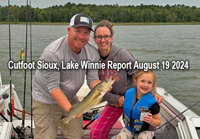 "Transition is routine during late summer and on both Lake Winnie and Cutfoot Sioux, we’re noticing lots of transition right now. Water levels are dropping, and aquatic vegetation is fully developed. Now, there are fish of all species using the shorelines, back bays and shallow flats.
"Transition is routine during late summer and on both Lake Winnie and Cutfoot Sioux, we’re noticing lots of transition right now. Water levels are dropping, and aquatic vegetation is fully developed. Now, there are fish of all species using the shorelines, back bays and shallow flats.
No transition is ever 100% and for sure, there are still walleyes located on mid-lake structure. Remember though, anglers have been targeting walleyes on bars and humps for about two months now, many of the active fish have been caught, and a lot of “harvestable” fish have been harvested. Add to that, insect hatches have run their course and forage on the smaller structures and some of the predators have moved toward other habitat. Fish that do remain on small, isolated “mud-humps” have been heavily pursued, and are more finicky, so catching them requires better timing.
Fish on the larger bars may be more difficult to pin down, but the “bar-fish” have more feeding choices and are more likely to ..." Read >> Cutfoot Sioux, Lake Winnie Fishing Report August 19, 2024 Lake of the Woods, LOW Tourism August 15, 2024
Lake of the Woods, LOW Tourism August 15, 2024
 "The great walleye bite continues on the south end of Lake of the Woods. Big numbers of both walleyes and saugers are staged over deep mud, a common and consistent late summer pattern on Lake of the Woods. The deep mud bite is occurring in 28 to 35 feet of water. Anglers are catching good numbers of fish on the mud using mainly two different techniques.
"The great walleye bite continues on the south end of Lake of the Woods. Big numbers of both walleyes and saugers are staged over deep mud, a common and consistent late summer pattern on Lake of the Woods. The deep mud bite is occurring in 28 to 35 feet of water. Anglers are catching good numbers of fish on the mud using mainly two different techniques.
Trolling with spinners with night crawlers is the presentation most anglers are using. A two hook crawler harness with a spinner blade colored in gold, gold-pink, pink, orange, glow-red, glow-white, or a combo of these colors. Drift or troll at 1 to 1.25 mph using a 2 to 3 ounce weight or bottom bouncer, a 2 hook crawler harness and a juicy crawler. This presentation covers water, puts your offering in front of numbers of fish and a combo of the flash, vibration and scent of the crawler are hard to pass by for a walleye or sauger.
Trolling crankbaits is also catching a lot of fish as well. With so many walleyes spread out over the miles and miles of mud over Big Traverse Bay, covering water is a good strategy. Strategically placing your lure in front of thousands of walleyes is effective. The chess game is what speed, what shape, what wobble, rattle or no rattle, in front of them or above them. Common crankbait colors are gold, blue-chrome, firetiger, pink UV firetiger, chartreuse and orange.
As an alternative to trolling, anchoring up over schools of walleyes and saugers and jigging with a frozen emerald shiner is still catching fish. Often, anchoring or spot locking with a jig around rocks or structure works well. When there are walleyes concentrated over mud, jigging can be effective there as well.
On the Rainy River, the slow summer flow of water continues to be great for fishing. A variety of species are being caught on the river. Sturgeon anglers are reporting good summer fishing. Set up in a hole of the river or the sloping bank from the hole to a flat and soak some crawlers or frozen emerald shiners (or both). A flat no roll sinker, sturgeon rig (18 inches of 60 lb test with a circle hook) with a glob of crawlers or combo of crawlers and shiners are catching fish. Evenings have been especially good. Many enjoy the peace and relaxation of the river in the summer.
Walleye anglers are trolling spinners and crawlers or crankbaits upstream covering water. If you find a school of walleyes, anchoring or spot locking with a jig and minnow will be effective. Smallmouth bass can be found near the rocky areas, current breaks, bridges with associated rip rap are all go to areas.
Up at the Northwest Angle, walleye fishing continues to be consistent. Some fish are on structure. Points, sunken islands, saddles, and neck down areas with current are just a few ideas. With 14,552 islands, there is a lot of structure! Other fish are sliding out to mud flats. Here, pulling spinners and crawlers to cover water works well. Lots of ways to get it done.
A mixed bag is common in the northern portion of the lake. In addition to walleyes and saugers, perch, crappies, pike, bass and even muskies are consistently caught while targeting walleyes." — Lake of the Woods Tourism, (800) 382-FISH
 Wired2Fish August 15, 2024 "Fothergill’s Neko Rig Method for Summer Bass"
Wired2Fish August 15, 2024 "Fothergill’s Neko Rig Method for Summer Bass"
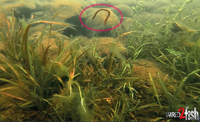 "Up-and-coming pro bass angler Easton Fothergill shares his personal approach to targeting largemouth bass on offshore structures with the Neko rig. Using his electronics with a combination of mapping, side imaging, and 2D sonar, Fothergill locates high-percentage areas where bass are likely to be schooled up. He explains the makeup of the ideal spot for schooling summertime largemouth and methodically picks them apart with this proven finesse setup.
"Up-and-coming pro bass angler Easton Fothergill shares his personal approach to targeting largemouth bass on offshore structures with the Neko rig. Using his electronics with a combination of mapping, side imaging, and 2D sonar, Fothergill locates high-percentage areas where bass are likely to be schooled up. He explains the makeup of the ideal spot for schooling summertime largemouth and methodically picks them apart with this proven finesse setup.
WHY THE NEKO RIG WORKS EVERYWHERE:
The Neko rig is one of Fothergill’s go-to baits, and he explains why it’s a must-have in every angler’s tackle box. The rig’s versatility allows it to be fished in various environments, from skipping under docks to dragging through deep grass beds. Fothergill’s experiences across many different lakes has shown him that the Neko rig consistently attracts bites, making it an essential tool for ..." View Video and Learn More >> Fothergill’s Neko Rig Method for Summer Bass
 August 14, 2024 "One Extreme Or Another"
August 14, 2024 "One Extreme Or Another"
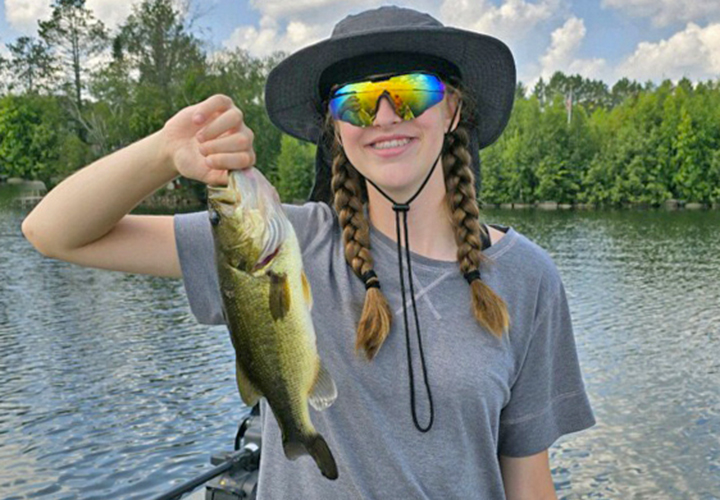 Family fishing trips, I mean the sort where moms, dads or grandparents treat their youngsters to guided fishing trips, are a big part of my summer. It’s a period that I look forward to, especially the mixed bag fishing trips that happen during this warm water period. Lately, I’ve been so focused on figuring out WHERE to take all these kids fishing that I forgot to realize WHEN it will all be over. Until this morning, I hadn’t realized that the family time of summer is already almost over!
Family fishing trips, I mean the sort where moms, dads or grandparents treat their youngsters to guided fishing trips, are a big part of my summer. It’s a period that I look forward to, especially the mixed bag fishing trips that happen during this warm water period. Lately, I’ve been so focused on figuring out WHERE to take all these kids fishing that I forgot to realize WHEN it will all be over. Until this morning, I hadn’t realized that the family time of summer is already almost over!
We’re already staring down the Labor Day holiday weekend and I think fishing yesterday with 14-year-old Olivia Smith and her dad Ryan might have been my last trip like this for a while. Like many, the Smith’s are due back in school soon, and once the classrooms and school sports start up, my season turns the corner, headed back toward fall fishing patterns.
The Smiths, you might recall, fished with me last Thursday August 9, 2024 and the two experiences could not have been more different. Last Thursday we fished on the leading edge of an inbound cold front, hoods pulled up, whitecaps crashing into the stern of my Alaskan and fish, some of them big ones, were biting fairly aggressively. Yesterday, the lake was mirror-glass clam, the sun was bright and the air was warm. There were fish biting, but only if we rooted them out of the weeds where they were hunkered down, waiting for a better opportunity to forage.
Our primary target, largemouth bass dictated the lake I selected, it’s 500 acres, has lots of shallow water and plenty of weeds. Bass, sunfish, northern pike, walleye and crappie are all present, and we usually catch some of everything on most typical visits there. Yesterday, we did catch a fair number of bass and sunfish, there were quite a few pike in the mix too, but except for the sunnies, most fish that we caught were on the smaller end of the spectrum. One nice crappie, caught by Ryan, and one suspected walleye strike on my rod were the only deviations from the bass-pike-sunfish mix.
Topwater baits, we hoped, would at least provide action during the early part of the trip but were totally ineffective yesterday. Jig-worms, 1/8-ounce heads with exposed hooks and 6 inch plastic worms provided some action. Going toe to toe with all of the weeds was tedious though, and it wasn’t long before I pulled out the Ugly Sticks and geared up for trolling spinners down the weed lines. This turned out to be the presentation that produced the most action.
As long as I kept the boat in the weeds, the fish bit periodically throughout the trip. The key depths ranged from 11 to 14 feet deep, depending on the weed varieties present at the time. The typical trolling speed, 1.1 to 1.3 MPH worked just fine. Whether we tipped our spinners with leeches, minnows or night crawlers seemed not to matter, there were fish of all species caught on all 3 variations. The one drawback to trolling was that despite the improved action, the average size wasn’t the greatest.
The larger fish, especially bass, were caught deeper on the weedline, on points in particular. When I offered up a Texas Rigged plastic worm, it was struck by an above average fish on the first cast and again on the second one. The aforementioned jig-worms fished deeper on the weedline caught the other larger size fish as well. Under different circumstances, I think these deeper, base of the weed line presentations would have been my primary game plan for the entire afternoon.
This morning, I was re-living the experience in my imagination. My Monday morning quarterbacking made me realize that I should have tried drop shotting yesterday. There were times when I marked fish along the deeper, outside edges of the weeds and I think some of them may have been susceptible to that presentation. With everything else going on, the idea just slipped my mind at the time.
Worth noting was that as the water temperatures rose, the action improved. When we started, the surface water was a cool 70 degrees and by days end, had reached 76 degrees. A few days of warmer weather, a few more clouds and a chop on the surface could easily bring back another round of mixed bag action, at least for a little while.
It’s no secret that I don’t look forward to working on calm, sunny days like we had yesterday. All things considered though; the trip was a good one. We kept on fish and accepted what the lake had to offer under the conditions we had to work with. We tried to be creative and in return, there was enough action to keep us busy most of the day. For me, it was easier than it could have been because Olivia is a fishing addict! Even with my boat on its trailer, the gear put away, the truck running and pointed toward home, she stood on the dock, catching little sunfish and bass on the last tiny morsel of night crawler meat. Trust me, that doesn’t happen too often!
Today, I’m in dry dock, headed for a finger surgery that hopefully will straighten out my bent ring finger. Wish me luck because if it works, I’ll be able to serenade you with another tune or two on my guitar in the off season. Which by the way, is now only a couple of moths away! They say I should be able to go back to work right away, and hopefully that’s true, I’ll let you know how it goes soon. ![]() — Office Cell Call or Text 218-245-9858 or Email
— Office Cell Call or Text 218-245-9858 or Email
 Ely Area, Arrowhead Outdoors Fishing Report August 14, 2024
Ely Area, Arrowhead Outdoors Fishing Report August 14, 2024
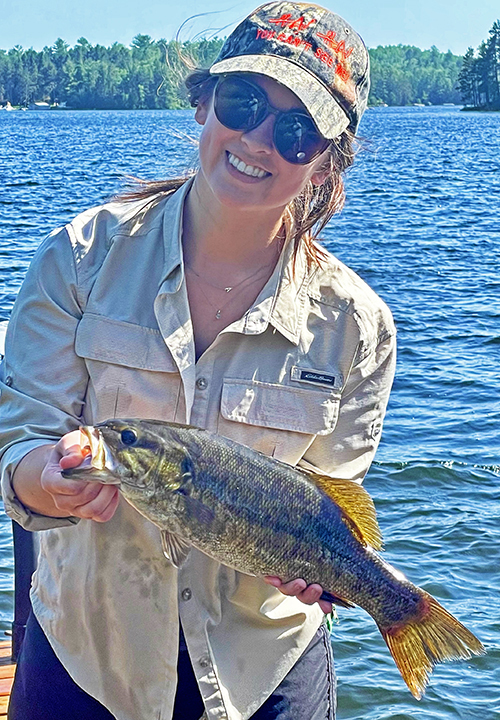 "Walleye - Yet another major cold snap swept through the Ely area last week, dropping water temps from 76 to 68 degrees. Clearly this has thrown a wrench into the walleye bite for many. Cold weather had anglers thinking of large minnows on a jig or lindy rigging. These anglers were not disappointed as they were able to catch walleyes while others struggled.
"Walleye - Yet another major cold snap swept through the Ely area last week, dropping water temps from 76 to 68 degrees. Clearly this has thrown a wrench into the walleye bite for many. Cold weather had anglers thinking of large minnows on a jig or lindy rigging. These anglers were not disappointed as they were able to catch walleyes while others struggled.
As weather conditions stabilized, walleyes have begun to bite again on spinner rigs, tipped with a crawler and slip bobbers with a leech floated over shallow rocks. Locations to find walleyes vary greatly from lake to lake now. Some lakes, river mouths have been hot, others sunken islands, weedlines, shallow rocky flats in 6 to 12 feet of water and for a handful of lakes, deep water trolling has been on fire. Hot colors remain orange/chartreuse, pink/white and gold.
Smallies - Smallies too can now be found in many locations. Shallow rocks and timber have been a good location for topwater fishing early in the mornings or cloudy days. As water warms up, big smallies have been sliding out to sunken islands where they feed on schools of ciscos. Here strolling large soft plastics has been deadly. Clearly not all smallies are doing the same thing, so anglers have also been finding smallies on shorelines with spinnerbaits and wacky worms.
Panfish - The sunfish and crappie bite has clearly cooled off. Dropping water temps kicked the sunnies out of the shallow water for a few days. Anglers found sunnies more on weedlines for a few days. Small wax worms were really effective on these guys. Last couple reports have the sunnies back up in weedbeds and pencil reeds. Small topwater flies, angleworms and small soft plastics have been effective again. Crappies have been hanging just off the weedbeds until the evening hours when they slide into the weedbeds. Beetle spins, jig/twister and small crankbaits have been effective here.
Stream Trout - Rainbows trout didn't seem to mind the recent cold snap. Anglers continue to do good with rainbow trout trolling cowbells tipped with a small crankbait or spinner rig with half a crawler.
Lake Trout - Lakers too didn't seem to mind the recent cold snap as anglers reported catching quality trout this last week. Anglers continue to use down riggers for dipsy divers down by the thermocline in 40 to 60 feet of water. Large flashy spoons have been the most popular lure to troll. Colors have varied greatly from angler to angler, so be sure to keep changing colors until you find the color of the day.
Pike - Pike fishing has remained somewhat slow as warm water temps have the big pike seeking cooler deeper water. Small pike continue to be caught by angler along weedlines, mouths of shallow bays and river mouths. Large spinnerbaits, minnow baits and spoons have been catching pike." — Arrowhead Outdoors, 218-365-5358
 Brainerd MN Area Fishing Report August 13, 2024
Brainerd MN Area Fishing Report August 13, 2024
 "After the large cold front that swept across the state last week, fishing was certainly more difficult this weekend. Surface temps dropped 7 to 10 degrees in a matter of a couple days and put the fish in a funk. With that being said, clients were still able to get some fish for dinner. Each day started by trolling spinners tipped with either crawlers or fat heads. Covering weed lines in 15 to 20 feet of water produced a multi-species bag of fish. Northern pike and bass were certainly more eager to bite but only 4 walleyes came on spinners for my groups this weekend.
"After the large cold front that swept across the state last week, fishing was certainly more difficult this weekend. Surface temps dropped 7 to 10 degrees in a matter of a couple days and put the fish in a funk. With that being said, clients were still able to get some fish for dinner. Each day started by trolling spinners tipped with either crawlers or fat heads. Covering weed lines in 15 to 20 feet of water produced a multi-species bag of fish. Northern pike and bass were certainly more eager to bite but only 4 walleyes came on spinners for my groups this weekend.
While watching side image carefully during our spinner program, I noted any pods of fish I observrd, and marked their locations. Then I would have waypoints already dropped so we could hit those spots once more with spinners to see if the fish were holding tight to irregularities on the weedline. After an hour of so of marking pods and only getting pike and bass, our group spun around using live image to throw bobbers right over the tight lipped schools of walleye. This produced several good eater fish to end our day but was a tougher way to get them than I would have liked.
With the cooler weather, and good winds, pods of fish were stacking up on inside turns located next to deep water. Larger fish could be found deeper but were very boat shy, not allowing us to get within 70 feet before spooking. Smaller eaters were grouped very tightly and if one was caught that pod would move away faster than you would imagine. Keeping on the move and persistence was the key to any success.
With a slight warm up this week, fishing will improve quickly and we fall into August patterns and spinners are used much more in my boat. As August progresses leeches will be almost completely phased out as my bait of choice. Soon, minnows will replace them as the fall bite begins, and fish begin foraging more heavily in preparation for winter." — Joe Billiar, Crooked Hat Guide Service
You Are Invited To Become A Duly Deputized Fishrapper Cub Reporter
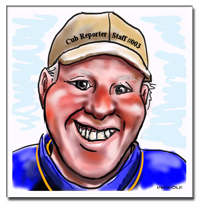 If you've been waiting for a gold engraved invitation to participate in the daily reports, then stop waiting and consider this your own personal invitation.
If you've been waiting for a gold engraved invitation to participate in the daily reports, then stop waiting and consider this your own personal invitation.
Helping your fellow fishermen and women stay abreast of fishing conditions in your area is good for everybody and it's easier than you think! You don't have to write a book, you don't have to share your secret fishing spots and you don't even have to mention your lake. But even a few words about general trends, seasonal patterns and local weather conditions can really help.
Be like me, become a duly deputized "Cub Reporter", it's good for fishing! Contact Us or if you prefer to be "social", Fishing Reports Minnesota, the Facebook counterpart to this page is open to the public, so you can post your own fishing update or just share a photo of a nice catch.
 August 11, 2024 "Just Another Crappie Fishing Day"
August 11, 2024 "Just Another Crappie Fishing Day"
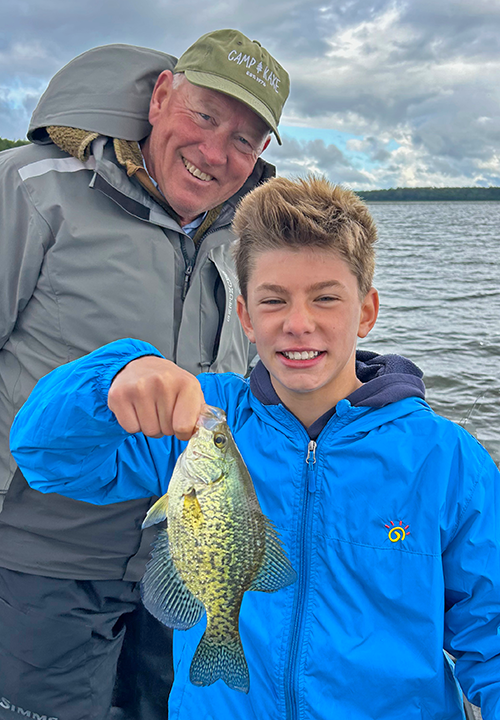 I can’t say that the Parrish family stayed warm and comfy on their fishing trip, in fact maybe a couple of them were pretty cold. The surface water, at 71 degrees felt like bath water compared to the northwest wind driven, mid-50 something, fall-like air temperatures. Luckily though, there was enough crappie action going on so that it made forgetting about the goose bumps a little easier.
I can’t say that the Parrish family stayed warm and comfy on their fishing trip, in fact maybe a couple of them were pretty cold. The surface water, at 71 degrees felt like bath water compared to the northwest wind driven, mid-50 something, fall-like air temperatures. Luckily though, there was enough crappie action going on so that it made forgetting about the goose bumps a little easier.
For most of our fishing day, the technical side of the fishing report wouldn’t surprise you. We trolled spinners tipped with fathead minnows along the outside edges of mixed cabbage, coontail and pondweed. The key depth ranged between 11 and 13 feet of water in the morning. Crappies were located close to the weeds, but not in them and that made it easier for the kids, Ty and Noah to troll without being snagged in grass too often.
Some of the fish held slightly deeper and that made it easier for their dad, Brandon to catch fish on “the deep side” of the boat. His spinner was tickling the 13–14-foot depth range, further away from the weeds, and it was being struck more often than the rest of the crew.
Because of that tight depth band where crappies held position, we may have gotten the impression that other fish species were not biting. I never proved that because when we left “the crappie hole” to explore for other fish species, the action slowed, and our focus on the cold temperatures intensified. That, combined with the fact that 5th and 7th graders require a little more action, made going back to the crappie hole sound like a great idea.
The return trip was my surprise of the day, fish that were holding in 11 to 13 feet of water had vanished. We trolled a long stretch of the shoreline, and there was only one fish caught. My instinct was to search deeper into the weeds, so I pulled the boat tighter to the weed edges, still nothing though. “If they didn’t move into the weeds, maybe they moved deeper”, I thought. So, I pulled out to the deep edges of the steep breakline and there they were, holding at 16 feet. That started up another flurry of action, and it held everyone’s attention for another hour.
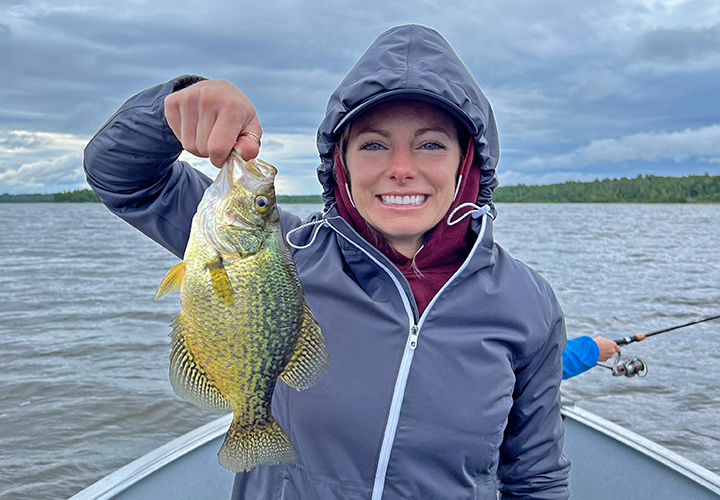 We were getting close to their limits of crappies, and if we were going to keep fishing, we’d have to move and experiment with other presentations. Cold air, a full livewell and renewed enthusiasm for warm food took over, and they decided to call it a day, rather than look for more variety.
We were getting close to their limits of crappies, and if we were going to keep fishing, we’d have to move and experiment with other presentations. Cold air, a full livewell and renewed enthusiasm for warm food took over, and they decided to call it a day, rather than look for more variety.
I’m not sure what we might have found if we’d kept fishing, but I do know what we didn’t find during the first half of our trip; almost nothing. Except for crappies and tiny perch, the typical mixed bag of fish on the weed edges was nearly non-existent. There was 1 small walleye, and 1 small pike caught, but that was it. No sunnies, no rock bass, no nothing.
I have to assume that if the crappies were active, so was everything else, but there was a disconnect between species and the habitat each of them preferred. If not that, then there may have been a disconnect between species and the presentations that each of them preferred. It’s too late to figure out what happened on this trip, and whether it constituted a change of patterns, or was a onetime weather-related disturbance. No matter what, this was a good day for Laura, Brandon, Ty and Noah. We ended the trip with 35 crappies, almost their full legal limits, seeing to it that their hope for a family fish fry would come true.
I’ll wrap with one last observation about the crappies themselves. Since the fall of 2022, when I reported about a strong, area wide year class of crappies, the average size has improved. That fall, fish in the 7-to-10-inch range were most common, right now, the average size ranges somewhere between 9 and 12 inches. On some of the lakes in the Leech Lake region, especially ones that have fast growth rates, this fall could well be the peak for anglers pursuing fish from that year class. ![]() — Office Cell Call or Text 218-245-9858 or Email
— Office Cell Call or Text 218-245-9858 or Email
 Wired2Fish August 11, 2024 John Cox’s Tips for Catching Fish Without Forward-Facing Sonar
Wired2Fish August 11, 2024 John Cox’s Tips for Catching Fish Without Forward-Facing Sonar
 "In bass fishing’s electronics era, John Cox stubbornly clings to his old-school ways. You won’t see him far off-shore, with his eyes glued to the screen of a forward-facing sonar unit that shows the real-time movement of bass.
"In bass fishing’s electronics era, John Cox stubbornly clings to his old-school ways. You won’t see him far off-shore, with his eyes glued to the screen of a forward-facing sonar unit that shows the real-time movement of bass.
He’s the one in an aluminum boat, traveling far up a creek or a backwater area to find unpressured bass living the good life in thick cover. He knows he is fishing in his comfort zone if he can jab his fishing rod into the water and touch bottom.
“I have a Lowrance Active Target unit sitting in the cab of my truck,” said Cox, who lives in DeBary, Fla. “I look at it constantly and think, “Is today the day? Am I going to use it today? But then I just decide to stay in my comfort zone. If I can’t ..." View Video and Learn More >> John Cox’s Tips for Catching Fish Without Forward-Facing Sonar
 August 9, 2024 "A Good Day To Be Olivia!"
August 9, 2024 "A Good Day To Be Olivia!"
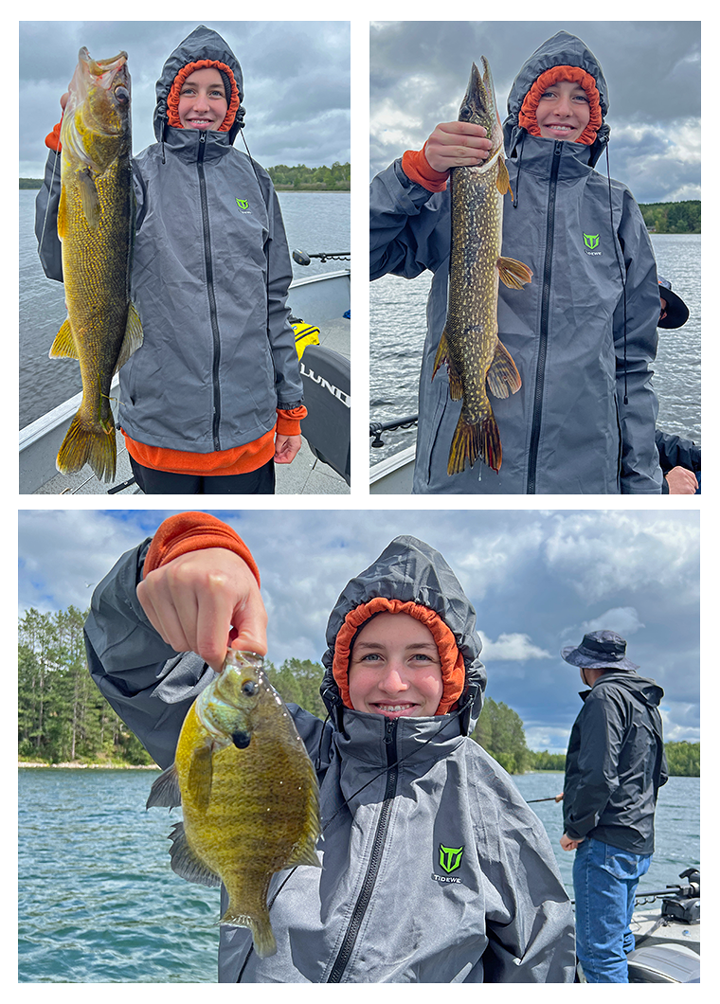 The goal of my fishing trip with Ryan and Olivia Smith on Thursday was to provide opportunities, primarily for Olivia, to experience catching a variety of fish species. As you can see, there was a variety, and some of them were of quality size.
The goal of my fishing trip with Ryan and Olivia Smith on Thursday was to provide opportunities, primarily for Olivia, to experience catching a variety of fish species. As you can see, there was a variety, and some of them were of quality size.
At 71 degrees, the surface water had fallen a full 9 degrees from my last trip to the lake we fished. Because of that cold front, and the falling water temperatures, the action was not fast and furious, but it wasn’t bad either. I was pleasantly surprised that the cold weather hadn’t slowed the action more than it did. The most noticeable difference was that sunfish and bass were less active than they were when surface temperatures were higher, but we still caught some of them.
Weed growth had not changed much, most of weed varieties remained green and strong. Cabbage, coontail, flat stemmed pondweed and northern water milfoil were the primary varieties of vegetation. Northern milfoil is one of the first varieties to disappear when the weather turns cold, but it still grew to the surface, forming thick matts and there was no significant decline so far.
On Thursday, and also on a different lake this Wednesday, we noticed that crappies were roaming further outside the weed edges than before. During some previous fishing trips, I had to always keep everybody in the weeds to keep the action steady. These past couple of days I could allow the boat to wander out into slightly deeper, more open water. Not only does that make it easier for the crew to fish, it also makes it easier for me to see fish on my sonar.
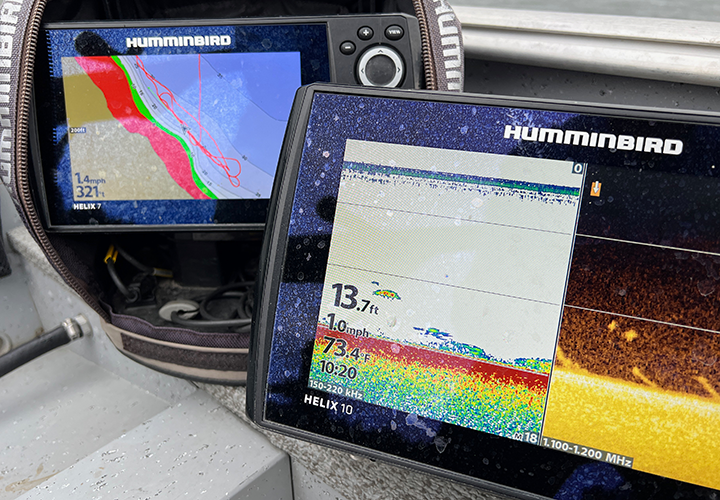 The image of my graph, taken on Wednesday when I fished with the Landsberg group illustrates a typical scenario for crappies. You can see that they appear in small, scattered packs rather than large schools gathering together. This helps explain why trolling spinners has been more efficient than casting jigs and plastics. We were able to catch some using 1/8-ounce jigs tipped with 3 inch Ripple Shads. But we caught fish at a faster rate when we trolled the spinners. Despite the slightly deeper water, we still used 3/16-ounce bullet sinkers without adding extra weight.
The image of my graph, taken on Wednesday when I fished with the Landsberg group illustrates a typical scenario for crappies. You can see that they appear in small, scattered packs rather than large schools gathering together. This helps explain why trolling spinners has been more efficient than casting jigs and plastics. We were able to catch some using 1/8-ounce jigs tipped with 3 inch Ripple Shads. But we caught fish at a faster rate when we trolled the spinners. Despite the slightly deeper water, we still used 3/16-ounce bullet sinkers without adding extra weight.
The crappies we caught on both days showed a strong preference for our spinners when tipped with fatheads. The sunfish and bass seemed to prefer leeches, medium size, added to the spinners. The walleyes we caught struck night crawlers, and the pike didn’t care what was on our hooks, they bit a little bit on all of them.
I’d like to be heading for Winnie today because that’s where my crew is staying. Today looks like another chilly one though, and I have a large crew, a family of 4 people who like action. So, I’m still debating how I want to handle it exactly, I could opt for the protection of smaller waters.
You may recall that back in July, I had an unexpected cancellation of a group that would have fished for 5 days. I was able to make up a couple of those cancelled dates, but I’m thinking that I’d like to make up a couple more of them, but I don’t have a ton of open dates available. Here’s what I’m thinking, Susan and I have reservations to be camping at Nodak Lodge on the south end of Lake Winnie on 8-22 through 8-26-2024. I’d be willing to turn our camping trip into a “busman’s holiday” providing that I can start and stop right there at Nodaks.
If you’d be interested in fishing on Winnie that weekend let me know and we’ll chat about the possibilities. Obviously, I’ll be on the water today, so for the fastest reply, a text to 218-245-9858 would be ideal. If you prefer emailing, I’ll be able to respond to your message later this evening. Thanks, bundle up to stay warm out there and have a fabulous day! ![]() — Office Cell Call or Text 218-245-9858 or Email
— Office Cell Call or Text 218-245-9858 or Email
 August 8, 2024 "Mixed Bag + Declining Water Temperatures = "Win Some, Lose Some"
August 8, 2024 "Mixed Bag + Declining Water Temperatures = "Win Some, Lose Some"
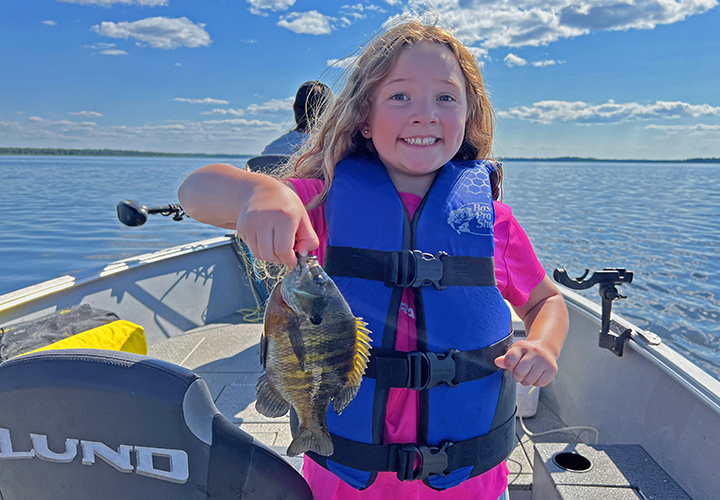 This morning, I’m in a rush to get packed up and out of the door early, so the updates will be short. Tomorrow, I’ll pick up where I left off, and add in whatever I haven’t shared about the past couple of days; here are the bullet points.
This morning, I’m in a rush to get packed up and out of the door early, so the updates will be short. Tomorrow, I’ll pick up where I left off, and add in whatever I haven’t shared about the past couple of days; here are the bullet points.
Water temperatures are declining, and the mix of fish that we’re finding on the weed lines is changing. As we fish the weed edges, trolling with spinners, sunfish are getting harder to catch. At the same time, nice size pike are getting easier to find. Walleye, crappie and bass located on the weed edges remains unchanged.
Walleye anglers have focused primarily on mid-lake structures for most of the past 6 weeks in the north central region. We’ve noticed that there are less fish in the middle of most lakes now, and more fish turning up on both shoreline related breaklines and larger, more expansive bars. With water levels remaining high, fish are more widely scattered than in a “typical” summer. But when located, they are active and fish we see on the screen of our electronics frequently strike.
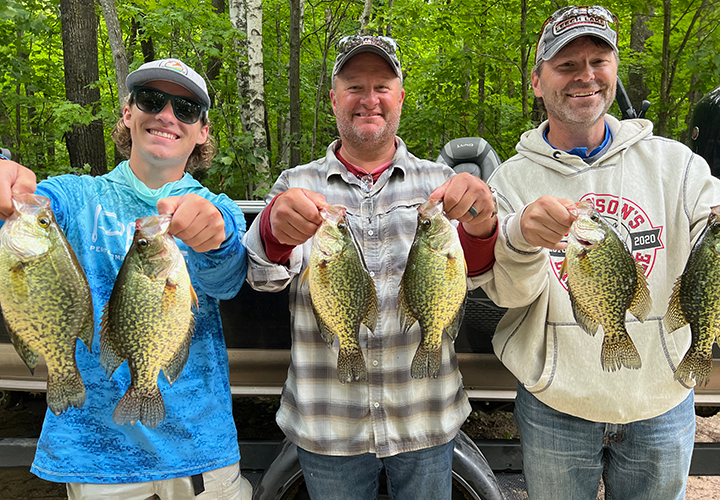 Crappies are beginning to push away from the heavy weed patches and have started to show up along the outer edges of the weeds. As they re-locate to the slightly deeper, and slightly more open terrain, they have become easier to locate. Again, with high water levels, crappies are alson more scattered than they have been in recent fishing seasons, but they too remain active. Trolling with spinners, tipped with fatheads has been a reliable presentation for me over the past few days.
Crappies are beginning to push away from the heavy weed patches and have started to show up along the outer edges of the weeds. As they re-locate to the slightly deeper, and slightly more open terrain, they have become easier to locate. Again, with high water levels, crappies are alson more scattered than they have been in recent fishing seasons, but they too remain active. Trolling with spinners, tipped with fatheads has been a reliable presentation for me over the past few days.
On many of the lakes I’ve fished this week, northern pike are showing up more frequently, and in some instances have been larger and fatter than ones we’ve caught previously. I’ve seen some early and limited signals that “summer kills” may be occurring on a couple of the lakes I’ve fished. As oxygen levels decline in deeper, cooler water areas, tullibees, suckers and other baitfish begin moving toward the shorelines and shallower, rocky habitats. Northern pike move in to take advantage of the bounty, and we may well be entering a period of improved pike fishing. That said, it depends a lot on what the weather does in the next days and weeks. I’ll be fishing for a pike today, and likely again tomorrow, so I’ll focus on updates about that.
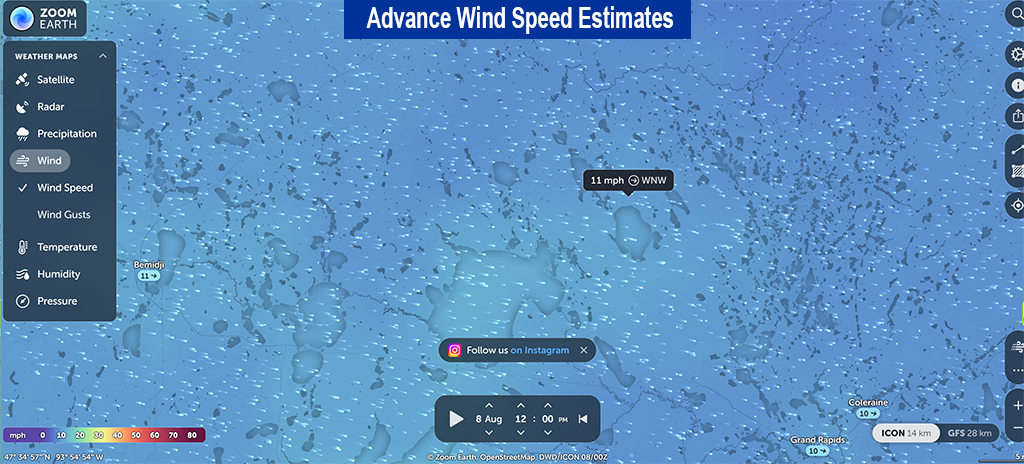 Wind direction and speed is one of the most important factors in determining which lakes, and which fishing spots, will be good on any given day. This morning, Bob Eckstrom, a reader who provides occasional comments sent me a link. Zoom Weather is the website, and on it, there’s a tool that allows users to get advanced predictions about wind direction and speed. It features an interactive map, so we can click on specific locations to see the estimated wind speed and direction for anyplace we want. There’s also a selection of the time, so we can get estimates of future wind conditions based on the time of day we plan to visit any given location.
Wind direction and speed is one of the most important factors in determining which lakes, and which fishing spots, will be good on any given day. This morning, Bob Eckstrom, a reader who provides occasional comments sent me a link. Zoom Weather is the website, and on it, there’s a tool that allows users to get advanced predictions about wind direction and speed. It features an interactive map, so we can click on specific locations to see the estimated wind speed and direction for anyplace we want. There’s also a selection of the time, so we can get estimates of future wind conditions based on the time of day we plan to visit any given location.
Obviously, this is new to me and I haven’t used it yet, but I will, starting today and if it works as good as it looks, this is going to be a very handy tool! If you’d like to take a test run of your own, use this link ZOOM EARTH WIND TOOL or click on the image to see it for yourself. By the way, this is not a paid promotion, or an endorsement. It just looks like a useful tool, so I’m sharing it with you. I’d appreciate your feedback about its usefulness to you after you try it for yourself.
Like I said, I’m in a rush right now, but if you tune in to the KAXE/KBXE at 6:20 AM, you will hear additional updates about these, and any other topics we discuss today. In the Grand Rapids area, use 91.7 on the FM dial. Brainerd and Bemidji area residents will find the program at 90.5 on your FM dial. The “early bird fishing guide” segment airs every Thursday morning at about 6:20 AM. ![]() — Office Cell Call or Text 218-245-9858 or Email
— Office Cell Call or Text 218-245-9858 or Email
 Ely Area, Arrowhead Outdoors Fishing Report August 7, 2024
Ely Area, Arrowhead Outdoors Fishing Report August 7, 2024
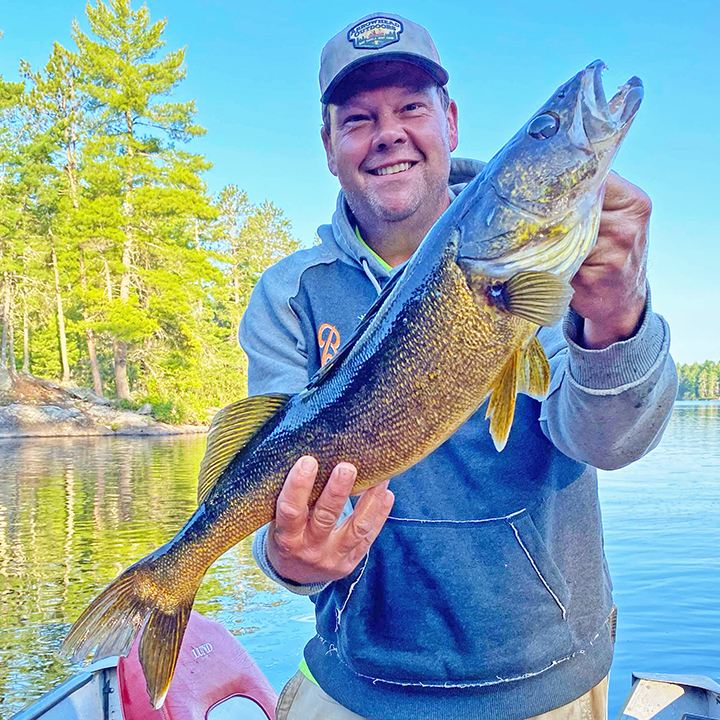 "Walleye - The sudden cool snap has cooled off the walleye bite this last weekend. Before the cold snap walleyes were increasingly sliding deeper and out onto mid structure like humps and points. Many anglers have been catching walleyes on spinner rigs tipped with crawler or a leech, in 12 to 17 feet of water now.
"Walleye - The sudden cool snap has cooled off the walleye bite this last weekend. Before the cold snap walleyes were increasingly sliding deeper and out onto mid structure like humps and points. Many anglers have been catching walleyes on spinner rigs tipped with crawler or a leech, in 12 to 17 feet of water now.
Orange, chartreuse and pink/white have remained the hot colors this week. Trolling season, for walleyes, is in full swing. Anglers trolling have been trolling during the evening hours in 15 to 25 feet of water. Large flats have been the areas to troll. On lakes with a healthy cisco population, anglers have been catching walleyes suspended 15 to 25 feet down, over 30 to 60 feet of water, chasing cisco. White and blood nose-colored crankbaits have been very effective here.
Smallmouth - Smallies have been back on the topwater bite this last week before the cold front came through. Since the cold snap anglers have had to slow down to more wacky rigs and Ned rigs, in order to catch smallies. As with the walleyes, smallies have been increasingly sliding out to mid lake structures, especially the big smallies. Smallies out here have been suspended off structure chasing cisco. Here anglers have been looking for them with forward facing sonar and dropping ½ ounce jigs tipped with soft plastic on them.
Panfish - Panfish seem to be enjoying this warm weather. Sunnies are being found in shallow water with thick weeds and or timber in the water. Small leeches or a piece of crawler, fished under a bobber has been very effective on these fish. Crappies on the other hand, are being found out just off weedline. Here beetle spins, small crankbaits and jig/twister have been very effective. During the evening hours crappies slide into the weed beds looking to feed.
Lake Trout - Lake trout fishing has remained constant this last week. Anglers continue to troll the thermocline, looking for actively feeding trout with large trolling spoons. Anglers fishing from a canoe have also been having good luck on smaller lake trout lakes. Here anglers have been jigging heavy bucktails and tubes of the bottom.
Stream Trout - Rainbows have remained active this last week also. Anglers trolling cowbells, tipped with small crankbaits remains the most effective way to catch rainbows. Anglers fishing from shore have been reporting good luck with floating a night crawler under a bobber 10 to 15 feet down." — Arrowhead Outdoors, 218-365-5358
 Wired2Fish "How to Fish Boat Docks for Bass With Weightless Wacky and Texas Rigs"
Wired2Fish "How to Fish Boat Docks for Bass With Weightless Wacky and Texas Rigs"
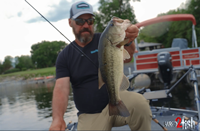 "In this video, professional angler JP DeRose demonstrates two effective dock fishing techniques for largemouth bass. DeRose provides insights on targeting bass using stickbaits rigged wacky style and Texas-rigged with both casting and spinning setups. Follow along as he explores the intricacies of dock fishing, offering tips on bait selection, casting strategies, and identifying productive stretches of docks.
"In this video, professional angler JP DeRose demonstrates two effective dock fishing techniques for largemouth bass. DeRose provides insights on targeting bass using stickbaits rigged wacky style and Texas-rigged with both casting and spinning setups. Follow along as he explores the intricacies of dock fishing, offering tips on bait selection, casting strategies, and identifying productive stretches of docks.
BASS FISHING BOAT DOCKS: Fishing docks is a time-honored technique among bass fishermen, especially those targeting largemouth bass. DeRose emphasizes the need to pay attention to the details, such as the spacing between docks and the proximity of deep water to the docks. He uses his map to locate docks adjacent to deeper water, providing bass quick access to varied feeding opportunities and water temperatures. DeRose discusses several good bait options that anglers can use to ..." View Video and Learn More >> How to Fish Boat Docks for Bass With Weightless Wacky and Texas Rigs
 Lake of the Woods, LOW Tourism August 7, 2024
Lake of the Woods, LOW Tourism August 7, 2024
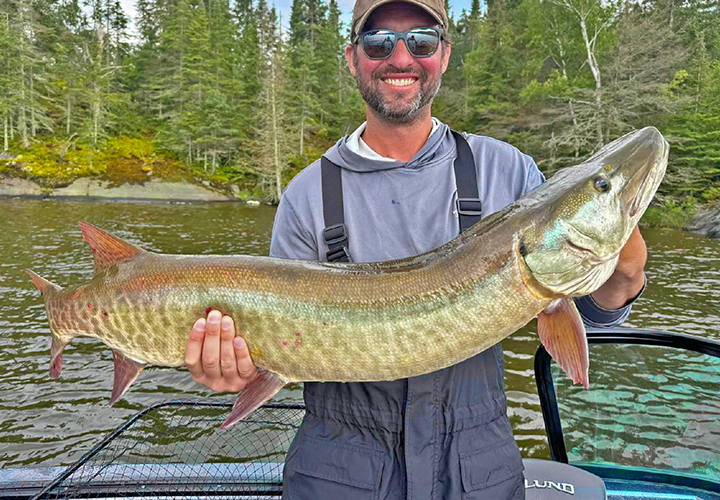 "The Dog Days of summer are a popular time on Lake of the Woods. While walleyes can be tough on other bodies of water with significant weed growth and millions of emerging perch and other baitfish, this is the time of year when L.O.W. shines! Huge schools of walleyes and sauger are set up over the deep mud and anglers are catching good numbers of fish using a few different techniques.
"The Dog Days of summer are a popular time on Lake of the Woods. While walleyes can be tough on other bodies of water with significant weed growth and millions of emerging perch and other baitfish, this is the time of year when L.O.W. shines! Huge schools of walleyes and sauger are set up over the deep mud and anglers are catching good numbers of fish using a few different techniques.
Most anglers are using spinners and crawlers. A two-hook crawler harness with a spinner blade colored in gold, gold/pink, pink, orange, glow red, glow white, or a combo of these colors working well. Crawler harness tip. Pinch off the long tail off the back of your crawler to just 2 or 3 inches off the back hook. This adds scent but most importantly and catches more walleyes. Walleyes will still hit the presentation and when they grab the crawler, they will have the last hook in their mouth.
Trolling crankbaits is extremely effective. With so many walleyes spread out over the miles and miles of mud over Big Traverse Bay, covering water and putting your lure in front of thousands of walleyes works well also.
Some anglers are still catching their walleyes anchoring up over schools of walleyes and saugers jigging with a frozen emerald shiner. Various rock reefs that come out of the mud in areas of the lake are also holding some fish. Some days, fish are on top. This time of year, the transition from rock to mud is a go to spot.
The flow of water on the Rainy River continues to decrease as do river levels. Clarity is good as is fishing. Sturgeon anglers continue to report good summer dinosaur fishing. This fish with strong prehistoric roots are being caught soaking crawlers and shiners. A no roll sinker, sturgeon rig (18 inches of 60 lb. test with a circle hook) with a glob of crawlers or combo of crawlers and shiners are catching fish. Fish can be caught all day, but evenings and even after dark were especially good.
Walleye anglers are covering water trolling spinners/crawlers or crankbaits upstream covering water. If you find a school of walleyes, anchoring or spot locking with a jig and minnow will be effective.
Smallmouth bass on the Rainy River do not receive the attention they deserve with the walleyes and sturgeon, but bass are up and down the river. Rocky areas, current breaks, bridges with associated rip rap are all go to areas.
The walleye fishing has been strong in the northwest angle as well. A 3/8-ounce jig with a minnow or plastic tail is effective when fished on structure. Some of the fishing guides use jigs in these parts all year long.
This time of year, fish start relating to sunken islands and even areas of mud just off the rocks. In this case, drifting or trolling crawler harnesses and trolling crankbaits cover water and catch nice fish. There are fish being found in various depths in 15 to 33 feet of water. This is a big range but consider the many different forage walleyes capitalize on. In addition, fluctuations in cold fronts and water temps will push fish to different areas.
Walleye anglers in these parts also catch perch, crappies, pike, bass and even muskies while targeting walleyes." — Lake of the Woods Tourism, (800) 382-FISH
 August 6, 2024 "Bowstring Lake: Re-Imagining Familiar Waters"
August 6, 2024 "Bowstring Lake: Re-Imagining Familiar Waters"
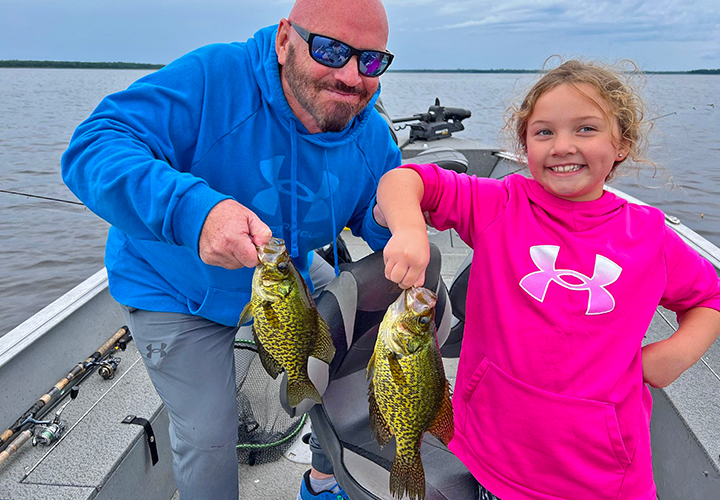 What would you do if you woke up one morning, walked out of your bedroom and discovered that your entire house had been remodeled overnight? Your original home was already comfortable, there was a recliner to sit in, a cozy kitchen for preparing meals, a patio outside and so on. Imagine that all of your original “habitat” was still there, and just as comfortable as ever. But now, your new remodel brings comfort to a whole new level! It features a huge addition, with at least a dozen new recliners, 8 fully stocked kitchens, 5 dining rooms, 16 bedrooms, 4 huge gardens and the list goes on. What do you suppose you would do with all that extra habitat?
What would you do if you woke up one morning, walked out of your bedroom and discovered that your entire house had been remodeled overnight? Your original home was already comfortable, there was a recliner to sit in, a cozy kitchen for preparing meals, a patio outside and so on. Imagine that all of your original “habitat” was still there, and just as comfortable as ever. But now, your new remodel brings comfort to a whole new level! It features a huge addition, with at least a dozen new recliners, 8 fully stocked kitchens, 5 dining rooms, 16 bedrooms, 4 huge gardens and the list goes on. What do you suppose you would do with all that extra habitat?
If you’ve fished on Bowstring Lake recently, then you know where I’m going with this. Since the invasion of zebra mussels, Bowstring’s waters have cleared, sunlight reaches deeper than ever before, and there is lush, green vegetation growing everywhere. Weed lines that used to end in water depths of 6 to 7 feet now don’t stop until they reach 10, 12 or more feet of water. Cabbage patches now cover huge portions of the lake’s mid-depth flats and can be found on all 4 sides of the lake. With all of that “new” habitat, fish have so many choices that they don’t know what to do with them all.
Earlier this summer, when the lake entered its summer peak period, and loads of walleyes were using classic mid-lake, catching them was easy. Now though, a lot of those fish have pushed toward the shorelines and have taken up residence in the weeds. When we find them, they bite, but the finding part takes longer, and the catching part requires more effort than before.
Until now, I’ve been finding fish by being stubborn; trying spot-after-spot until I finally locate some fish. It works, but trial and error takes a long time, and I haven’t always been happy with the time I’ve spent finding fish, but recently, it’s getting easier.
I’m not saying that I have this all figured out, and I’m still low on the learning curve. That said, I do know one thing that will help you on your next trip to Bowstring, the best spots are ones that feature the widest array of habitat types all in one place. For instance, any given cabbage patch might host a few fish. But a cabbage patch, adjacent to a rock pile, located near a deep breakline will likely hold more. Add more weed types, clam beds, gravel patches and the spots get even better. For me, applying the familiar “spot-on-a-spot” thought process to every patch of weeds is helping me re-imagine the best places to find the fish.
Yesterday, after a lot of searching, I figured out that the crappies you see pictured here were holding on a shoreline break in 6 to 7 feet of water, over a patch of eelgrass that lays adjacent to a patch of gravel and light rocks. To catch them, we trolled using spinners tipped with minnows. But if I’d been fishing with advanced anglers, with the skill to cast small jigs and plastics, I would have done that instead, I think it would have been more efficient.
On another spot, we found a mix of perch, pike and sunfish in 10 feet of water. There they were holding over a sparse patch of weeds that grew amidst another gravel patch, this patch of hard bottom lays adjacent to the steep breakline leading into the lake’s deep-water basin. Again, we caught those fish using spinners, but here too, small jigs tipped with live bait might have been the more efficient choice.
What about the walleyes, you may be wondering? Well, last week, the best ones we caught were located in the same “spot-on-a-spot” hard bottom, weed patch combinations. Yesterday, it appeared that the stormy weather was a setback for walleyes; they did not show up in the weeds. We picked up a few walleyes on a rocky patch located in 12 to 14 feet of water and we used ¼ ounce jigs tipped with leeches to catch those. Mid-lake bars and humps that have been popular for most of the summer did not have many fish on them yesterday. As the weather stabilizes, that will probably change and if I’m back out there to find out, I’ll let you know.
Today is day 3, and the last trip with the Patterson clan for this summer. First, 11 year old landry wants to take a crack at some bass and pike with his dad. Then grandpa and somebody will share the afternoon with me, we’ll be hoping for a good mixed-bag spinner bite, I think. This will be my first “pre-meditated” bass fishing trip of the summer, and with luck, I’ll have some great news to share about that tomorrow. ![]() — Office Cell Call or Text 218-245-9858 or Email
— Office Cell Call or Text 218-245-9858 or Email
 August 5, 2024 "Bait and Switch, or Vice Versa?"
August 5, 2024 "Bait and Switch, or Vice Versa?"
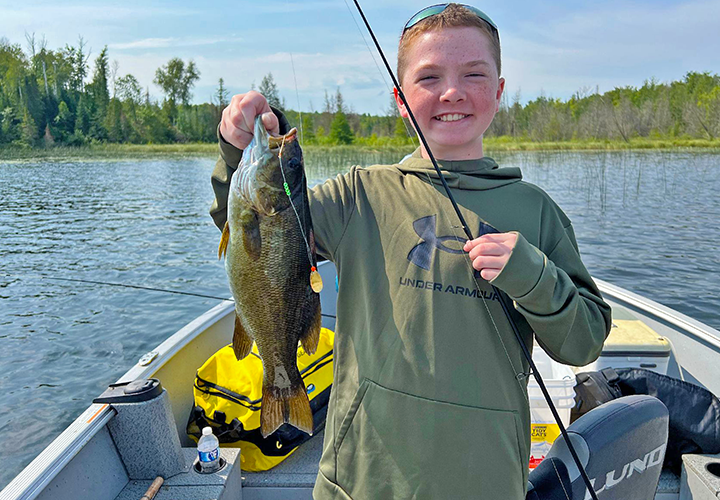 Figuring out how fish respond to changing weather conditions is fascinating. Realize this, without doubt, it is an art, not a science. An experienced angler may learn enough about fish behavior to help make decisions about fish location and presentation more quickly. But the longer and harder I try, the more I realize that I can never eliminate the process of trial and error. Making “educated guesses” about where to start on any given day, is the best I can do.
Figuring out how fish respond to changing weather conditions is fascinating. Realize this, without doubt, it is an art, not a science. An experienced angler may learn enough about fish behavior to help make decisions about fish location and presentation more quickly. But the longer and harder I try, the more I realize that I can never eliminate the process of trial and error. Making “educated guesses” about where to start on any given day, is the best I can do.
Yesterday, on the heels of my fishing trip with the Hippie Chick on Saturday, I was excited to pick up where we left off. I met my crew, Patrick and Landry at the landing, motored to the spot where Susan caught her walleye and explained the wiggle worming presentation. “Keep the rod tip moving”, I explained. “When you feel a slow-steady pull down, release the line, let the fish have time to eat the night crawler, then reel up the slack until you fell the fish and set the hook.” It sounds like an easy presentation, doesn’t it?
On Saturday, wiggle worming was the exact best way to prevent small sunfish from robbing the bait from our spinners. On Sunday, wiggle worming was the exact worst way to accomplish the same goal. One effect of the thunderstorms that struck on Saturday was to move the small sunfish out of the weed flats, and down to the deeper stretches of the breaklines. There was no way that my crew could follow my instructions because the instant we dropped our baits in the lake, they were attacked by legions of tiny panfish. The average night crawler lasted about 5 seconds before it was chewed up and taken away. Leeches, fished on drop shot rigs suffered the same fate and it was frustrating to say the least.
We didn’t have much choice, if we wanted to keep fishing, we’d have to abandon the night crawlers and find something that the sunnies wouldn’t attack. Trolling spinners, tipped with fatheads is usually a good way to do that, so we swapped our fishing rods and began trolling.
The first few spots were similar to each other and were much like the spot where we’d found some walleyes on Saturday. Shallow, weedy free-standing flats, surrounded by deep water. I focused on the points, expecting that the walleyes, pike and bass might be found on them. It didn’t take that long to learn that these shallow weed flats were not the ticket to catching fish. After 3 or 4 attempts, the best we had done was to pick up a few smaller largemouth bass.
Landry, the 11-year-old you see pictured, actually said it first. “Maybe we should try fishing closer to the weeds?” What he meant was that we should fish closer to the bulrushes, the tall green plants that grow above the water. In a lot of lakes, bulrushes grow close to steeper breaklines, and I thought his idea was a good one. “Let’s give it a try”, I agreed, and we began trolling the breakline adjacent to a long stretch of submerged cabbage that grew adjacent to the bulrushes. It was the cabbage that actually held the fish, but the emergent bulrushes provided a visual map ot where the were.
Trolling along the steeper breaklines turned out to be the pattern for our day. No matter where we fished from then on, our best action always came from areas where cabbage, coontail or other deep growing weeds laid adjacent to steep breaklines. Inside corners were better than points too, and the combination of steep, inside turns, adjacent to deep water provided almost all of our “better fish” for the day.
I kept experimenting with other baits. But panfish stealing worms and leeches was a problem that never ended on Sunday. So, whether trolling spinners with minnows was the best presentation or not, it was the only way I could keep this crew in the action, and it served us well enough. We didn’t catch a ton of any single species, but cumulatively they added up to a decent day. By the day’s end, we had caught largemouth, smallmouth, pike, crappies, walleyes, sunfish and 1 lonesome rock bass.
Today, with the same crew, I’ll be trying a different lake hoping to zero in on more walleyes, we’ll see how works out.
Yesterday, when the Hippie Chick read my report, she told me that she was amazed by how different my account of the trip was, compared to hers. “Well, write it up and I’ll offer folks your version of the story”, I said. So, she did, and here it is, The Hippie Chick’s Fish Tale, in her own words.
 “Yesterday, (8-3) I was invited to pre-fish a lake with Jeffrey for an upcoming trip. It was a beautiful lake, remote with lots of interesting structure. The weather had been hot, but this early morning, the skies to the north were dark and ominous. Maybe, if we were lucky, we would have enough time to complete the mission.
“Yesterday, (8-3) I was invited to pre-fish a lake with Jeffrey for an upcoming trip. It was a beautiful lake, remote with lots of interesting structure. The weather had been hot, but this early morning, the skies to the north were dark and ominous. Maybe, if we were lucky, we would have enough time to complete the mission.
The lake was loaded with weeds which had me imagining all kinds of different fish, especially big ones! We started out by trolling spinners, with a less than spectacular run at anything keeper sized. But during that run, Jeffrey started to reminisce about his history with this lake which more than made up for the lack of any catching action. Turns out this was the lake where he started out as a fishing guide.
There were memories of driving up from Minneapolis to do guided trips out of one of the resorts, a resort that made fresh donuts every morning for their guests, stories about family members and friends, many who have passed on. And then the story about catching a 12 /13-pound pike in his little john boat! I loved listening with my heart and senses wide open.
But, when Jeffrey said wiggle worming was calling to him and that’s what we were going to try next, I got excited. I hadn’t done this presentation for a year or more. Jeffrey threw my line out and handed me my pole. I quickly realized I needed a tutorial to remember how it goes…. cast, open the bail hold the line, and wait it out through numerous weeds tugging on the line.
Wait, was that the tug I had been waiting for? Remember, feed line, just in case. After waiting for what seemed like forever… time to close the bale. (By the way, there’s no way to tell when enough time has passed, you just have to feel it) Holding my breath, I slowly started reeling in until all the slack was gone. The moment of truth had arrived. A weighted pull- down on the line meant things were about to get interesting! Then I heard Jeffrey say, “Set the hook sweetie,” at about the exact moment I was saying the same to myself!
There’s no better thrill than the moment you KNOW there’s a fish on, and it’s twisting and turning trying to get off. So, when this fish finally landed in the boat, and spit out the hook, I knew I had just gotten very lucky.
Shortly after that, the skies were darkening with strange looking layers of clouds forming. Any thought of lingering disappeared when a streak of lightening sent us headed for home. Mission accomplished and another story for the remembering.” ![]() — Office Cell Call or Text 218-245-9858 or Email
— Office Cell Call or Text 218-245-9858 or Email
 August 4, 2024 "Wiggle Worming: The Gift That Keeps On Giving!"
August 4, 2024 "Wiggle Worming: The Gift That Keeps On Giving!"
 Sometimes I get special requests from customers who want to fish on a specific lake. Most often, they are folks who recently purchased property, or have rentals reserved on the lake, and they want to use me to get familiar with it. I have a trip like that coming up today, and I wanted to be ready for it. So, Saturday was supposed to be a “busman’s holiday” for me. I and the Hippie Chick had planned to spend some time getting re-acquainted with a lake that I once knew well but haven’t fished for a long time since.
Sometimes I get special requests from customers who want to fish on a specific lake. Most often, they are folks who recently purchased property, or have rentals reserved on the lake, and they want to use me to get familiar with it. I have a trip like that coming up today, and I wanted to be ready for it. So, Saturday was supposed to be a “busman’s holiday” for me. I and the Hippie Chick had planned to spend some time getting re-acquainted with a lake that I once knew well but haven’t fished for a long time since.
The day began like most others, we arrived at the landing, got checked in by the A.I.S. inspector, then launched the boat and started looking around. The surface temperature of the 836-acre lake was 77 degrees, the weed growth was thick. Mid-lake structure on the lake is minimal, and on the flats, dense mats of northern milfoil, and coontail choke out the shallow flats. So, for fishing, the only game in town is to search for fish along the weed edges, which in the lake’s gin clear water, grow deep, out to 22 feet of water in most places, sometimes even deeper than that.
 The first spot we tried was a long weedy point adjacent to the shoreline and tapers out into deep water. We picked up the outermost edges of the weeds and began trolling spinners, mine tipped with a crawler, hers tipped with a medium size leech. Sunfish nipped at the baits, but nothing of any size and there were no crappies, pike or walleyes either. At the second spot, we had similarly unproductive results using spinners. “Okay honey let’s put the spinners away and try something else. Let’s try the wiggle worms here before we move away,” I said.
The first spot we tried was a long weedy point adjacent to the shoreline and tapers out into deep water. We picked up the outermost edges of the weeds and began trolling spinners, mine tipped with a crawler, hers tipped with a medium size leech. Sunfish nipped at the baits, but nothing of any size and there were no crappies, pike or walleyes either. At the second spot, we had similarly unproductive results using spinners. “Okay honey let’s put the spinners away and try something else. Let’s try the wiggle worms here before we move away,” I said.
I drove back out to the tip of the point, deployed the wiggle worms and let the light breeze drift us along the weedline. Not long after that, the Hippie Chick started feeding out line, then closed the bail, reeled up all of the slack line, watched the rod tip load up, and then … set the hook. The fish, as it turned out was a fat 19 inch walleye and would be our dinner, more on that later.
If this had been an ordinary fishing trip, we’d have stayed on that spot longer, but it wasn’t. We already knew what we knew about that place, and I was interested in locating crappies, bass or pike. So, we motored into a small, 56 acre connecting lake that had darker water, and a shallower weedline. The small lake has potential as a panfish and pike spot, so we returned to trolling with spinners on the 12-to-16-foot, weedy breakline. There were plenty more sub-standard size sunfish striking our spinners, but there were no ‘keepers” of any kind. So, we motored back out to the main lake, and stopped at another weedy point, where I planned to do more wiggle worming.
“Did you see that,” the Hippie Chick asked? “You mean that lightning over there”, I responded? I checked out the radar screen on my phone, saw that we had a line of thunderstorms bearing down on us. At the time, we didn’t even know that it would storm for most of the afternoon, we just knew that there was no need to stick around for the one that was coming. So, we motored back to the landing, loaded up the boat and drove back to Grand Rapids.
 On the drive home, I speculated about what we’d have for dinner, and mentioned that we could use her fish to prepare coconut broiled walleye. The idea sounded good and when we got back into town, we stopped at Clayton’s produce stand to pick up a fresh batch of sweet corn to go along with it. At home, one thing led to another and we decided that updating the recipe page would be a good idea, so we snapped a few photos to document the process.
On the drive home, I speculated about what we’d have for dinner, and mentioned that we could use her fish to prepare coconut broiled walleye. The idea sounded good and when we got back into town, we stopped at Clayton’s produce stand to pick up a fresh batch of sweet corn to go along with it. At home, one thing led to another and we decided that updating the recipe page would be a good idea, so we snapped a few photos to document the process.
While I was preparing the meal, Susan reflected on her fishing experience. “You know what I like about wiggle worming? It’s like opening a gift on Christmas morning. Once you feel the strike, then feed out the line, the suspense starts building as you gather up the slack line and feel the tension on the rod tip. Tearing into the wrapping paper of the the gift is when you set the hook and feel the weight of the fish. Then when you see the golden walleye coming to the net and realize the gift you’ve received.”
If you’ve recently received the gift of a nice walleye, and would like to try one of our favorite recipes, then follow the link to >> Coconut Broiled Walleye
Today, I’m headed back to the same lake, hopefully to catch a few more fish for my customers. We’ll soon learn whether or not that line of thunderstorms makes it harder or not. Tomorrow, I’ll let you know how it goes. ![]() — Office Cell Call or Text 218-245-9858 or Email
— Office Cell Call or Text 218-245-9858 or Email
 Cutfoot Sioux, Lake Winnie Fishing Report August 3, 2024
Cutfoot Sioux, Lake Winnie Fishing Report August 3, 2024
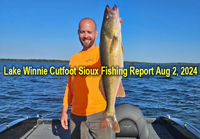 "Walleye fishing on Lake Winnibigoshish remains good, but timing your trip for early morning and late evening is a very good idea. Daytime fishing can be good if the conditions are favorable for walleye feeding. Overcast skies combined with moderate winds continue to produce good action. When the sun is shining, and the water is calm, the bite slows considerably. Ironically, folks have been catching some of the largest walleyes during periods when the action is slow.
"Walleye fishing on Lake Winnibigoshish remains good, but timing your trip for early morning and late evening is a very good idea. Daytime fishing can be good if the conditions are favorable for walleye feeding. Overcast skies combined with moderate winds continue to produce good action. When the sun is shining, and the water is calm, the bite slows considerably. Ironically, folks have been catching some of the largest walleyes during periods when the action is slow.
Most folks continue to fish over mid-lake structures, particularly smaller free-standing humps. Most of them top out at 16 to 22 feet and are surrounded by water depths of 30 to 35 feet. The most active walleyes tend to gather high on the edges, key depths vary between 16 and 24 feet. Sometimes walleyes move deeper on the breaklines, but there are a lot of fish that move away horizontally and suspend. It has been common to see walleyes suspended at 18 to 20 feet over the 30-to-35-foot soft bottom basin.
The suspended fish have been difficult for most anglers to catch, but there are some pros who manage to ..." Read >> Cutfoot Sioux, Lake Winnie Fishing Report August 3, 2024
 August 1, 2024 "Mixed Bag, What Mixed Bag?"
August 1, 2024 "Mixed Bag, What Mixed Bag?"
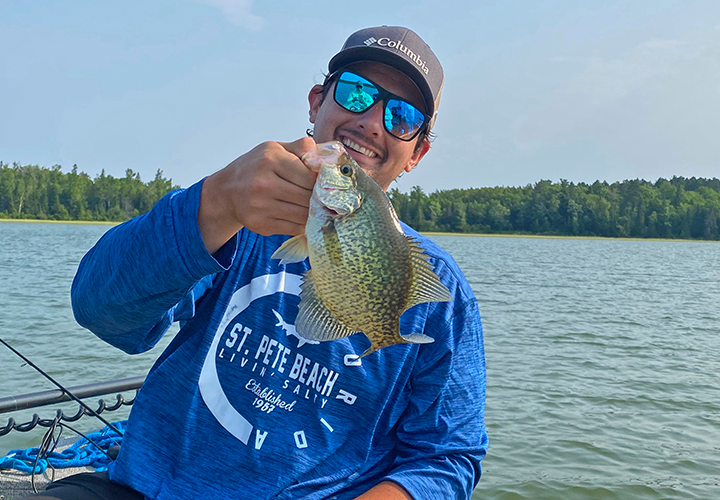 Fans, like me, of trolling the weeds for a mixed bag of fish species might have noticed that there’s something different going on in the north central regions this summer. If you wanted to, you could head for the lake today and find someplace where trolling spinners will produce a fabulous catch of bluegills. The same is true for crappies, bass, pike, and walleyes too for that matter. What has been harder to find this year, for me at least, is one place where you can catch all these fish species at the same time.
Fans, like me, of trolling the weeds for a mixed bag of fish species might have noticed that there’s something different going on in the north central regions this summer. If you wanted to, you could head for the lake today and find someplace where trolling spinners will produce a fabulous catch of bluegills. The same is true for crappies, bass, pike, and walleyes too for that matter. What has been harder to find this year, for me at least, is one place where you can catch all these fish species at the same time.
Take yesterday for example, Phil, Jonah and Tom were up for a mixed bag fishing trip. Jonah was hoping for crappies, Phil had his heart set on bluegills, and Tom hoped for some walleyes in the mix. I had a few lakes in mind, all of them in different directions from each other.
I was hemming and hawing along the route between Grand Rapids and Fred’s Bait in Deer River. Even after we picked up our bait and left the shop, I hadn’t settled on our final destination. In my mind, I had an image of three lakes, located within 15 miles of each other, and picked the one in the middle of the circle. I figured that we’d start there, then move to another if necessary.
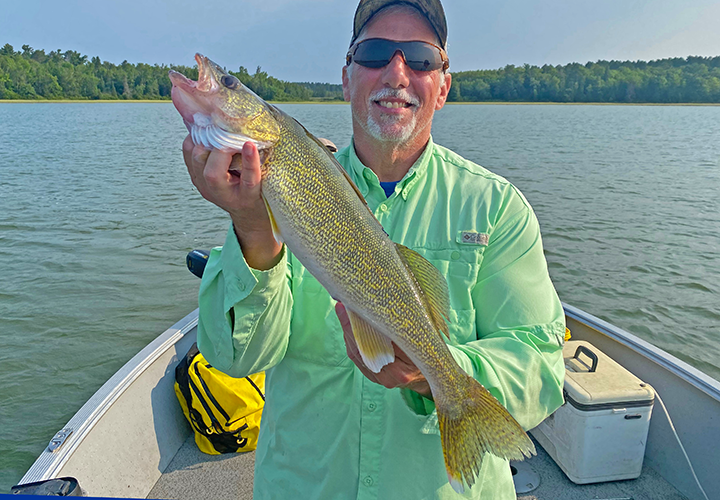 When we arrived, there was only a light ripple on the water, the sun was shining, and the surface temperature was 77 degrees. If we were going to find walleyes, we better try to find them right away, I thought. So, I headed for a small, shallow weed bar where I’ve found walleyes in the past. I stopped the boat, started the trolling motor, asked the boys to toss their spinner into the water and … WHAM! Somebody caught a crappie, then I caught a sunfish, then Phil caught a nice walleye. By the time we finished fishing that spot, I figured that the rest of our day would be easy.
When we arrived, there was only a light ripple on the water, the sun was shining, and the surface temperature was 77 degrees. If we were going to find walleyes, we better try to find them right away, I thought. So, I headed for a small, shallow weed bar where I’ve found walleyes in the past. I stopped the boat, started the trolling motor, asked the boys to toss their spinner into the water and … WHAM! Somebody caught a crappie, then I caught a sunfish, then Phil caught a nice walleye. By the time we finished fishing that spot, I figured that the rest of our day would be easy.
In one sense, the rest of our day was easy, it was never very long between strikes, and there was always somebody catching something. But it was evident that as we moved from one place to another, the frequency of strikes diminished. So did the variety of fish species, the sunfish that struck in the morning became very hard to track down, and the walleyes that we caught were almost all too small for harvesting. Crappies became the focus of our efforts, and they did hold up their end of the bargain. At days end, we had saved enough “keepers” for each of them to return home with a limit.
The day before, calm seas and sunny conditions also affected my annual fishing trip with Bob Slager, his son-in-law Joe and this year, for the first time, Ben, his grandson. We spent the entire day fishing on Bowstring Lake where I had gotten in on a good, mixed bag trolling pattern on a previous trip. Tuesday was different though, the sunshine and calm seas made trolling the weeds much more challenging. Small pike were hitting, they always are on Bowstring, but the crappies, perch, and walleyes did not respond to trolling spinners at all. Instead of trolling the weeds with spinners, we moved to deeper, mid-lake structures and slowly chipped away at walleyes out there.
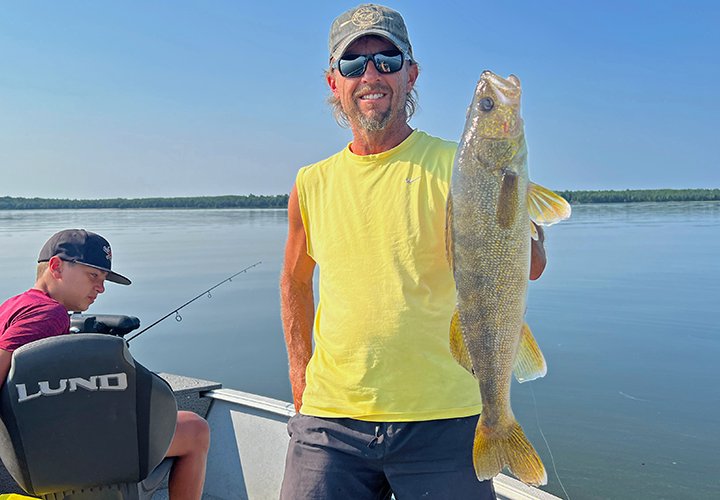 Our best presentations involved jigs tipped with leeches. Sometimes, we used slip-floats, combined with 1/16-ounce live bait jigs and leeches to catch fish that I spotted on the graph. On other spots, we dropped ¼ ounce live bait jigs with leeches, and fished slowly. Holding the jigs steady, letting the leeches do all of the work, I crept along the edges of bars at .3 to .5 MPH. This feels like a S-L-O-W way to fish, but it works, and it allowed us to put the better fish into the livewell. Without doubt, it was a grind, but we did end up with 11 walleyes, a much better outcome than we were headed for using the spinners.
Our best presentations involved jigs tipped with leeches. Sometimes, we used slip-floats, combined with 1/16-ounce live bait jigs and leeches to catch fish that I spotted on the graph. On other spots, we dropped ¼ ounce live bait jigs with leeches, and fished slowly. Holding the jigs steady, letting the leeches do all of the work, I crept along the edges of bars at .3 to .5 MPH. This feels like a S-L-O-W way to fish, but it works, and it allowed us to put the better fish into the livewell. Without doubt, it was a grind, but we did end up with 11 walleyes, a much better outcome than we were headed for using the spinners.
I have already shared with you the case of Big Sandy Lake’s disappearing walleyes. Since I published that update, I’ve heard from folks on other lakes who have experienced similar mysterious disappearances. While their stories have been similar in one sense, they also vary in another, the fish species that they report “disappears” from the mix, are different in every case. Like me, they can usually find some kind of fish to catch, they just can’t find all the fish species that they’re accustomed to catching. As usual, I have a working theory, proving it will take some time.
My working theory is that high water and cooler temperatures, combined with increased water clarity have created a wider variety of habitat types. That could mean to the fish that there are fewer less-than-ideal places that fish are forced to inhabit, and more “ideal” places for them to inhabit by choice. If you think about it, it makes sense, during years with average water conditions, there are simply fewer places for fish to hide out. More of them get crammed into the outer edges of weed beds, far away from shallow sanctuaries that they can access right now.
What makes me want to double-down on this theory is that the fish most likely to inhabit shallow water, bass and sunfish, happen to be the same ones missing from many of the places I’ve taken my customers too recently. Almost every day, I repeat the same sentence to them, “I don’t think it’s because the fish aren’t biting, I think it’s that they’re scattered and harder to find.”
Let’s back up to Tuesday’s trip, once we figured out where the walleyes were located, we caught some of them. Despite less-than-ideal fishing conditions, we were able to trick a decent number of them into striking. Yesterday, when we stopped catching sunfish, they were probably still biting, if I would have stopped fishing the weed edges, and fished in shallower, heavier cover, we may have caught a lot of them.
The correlation between high water and increased shallow habitat is one piece of the puzzle. But while we’re considering that, we also have to take into account that the waters with zebra mussels, like Bowstring, have a deeper weed habitat for the fish to use too. Right now, you can find thick patches of lush green cabbage on Bowstring growing in water depths of 9 to 11 feet of water. That would have been unheard of 10 or 15 years ago when the deepest weeds would have grown out to maybe 6 or 7 feet of water. The last time I fished on Bowstring during a cloudy, breezy day, we caught walleyes, crappies, perch, sunfish, bass and more, all fishing the outer edges of weeds in 9 to 10 feet of water. On Tuesday, sunshine and calm water seemed to have forced fish to leave that structure, I think because it was too bright for them in those areas.
My assessment of the situation is so subjective that I may never prove any of this. In fact, the only way I’ll be able to prove any of it will be when the water conditions change back to a more typical level for this time of the season. That said, if you’re into thinking about fishing as an art, and not a science, then you might not need proof. I think that even if they’re only theories, they might help you figure out a pattern that works for you, on your favorite lakes. If they do, I wish you’d let us know, it could be of great help to our fellow anglers. ![]() — Office Cell Call or Text 218-245-9858 or Email
— Office Cell Call or Text 218-245-9858 or Email
 Wired2Fish "Ripping Pike and Walleye with Lipless Crankbaits"
Wired2Fish "Ripping Pike and Walleye with Lipless Crankbaits"
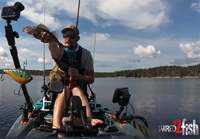 "Today we demonstrate how to catch numbers of pike and walleye on lipless crankbaits. And you can easily do it from a boat or as is the case in this video, a kayak. It’s a simple effective method to cover a lot of water and catch numbers of fish, even when the conditions are less than optimal for walleye fishing, i.e. slick calm and sunny. With a fishing kayak and spinning rod and reel combo, some light braid with a fluoro leader, you can take a lipless crank like the Rapala Rippin’ Rap and cover large swaths of the body of water efficiently.
"Today we demonstrate how to catch numbers of pike and walleye on lipless crankbaits. And you can easily do it from a boat or as is the case in this video, a kayak. It’s a simple effective method to cover a lot of water and catch numbers of fish, even when the conditions are less than optimal for walleye fishing, i.e. slick calm and sunny. With a fishing kayak and spinning rod and reel combo, some light braid with a fluoro leader, you can take a lipless crank like the Rapala Rippin’ Rap and cover large swaths of the body of water efficiently.
In this video, McKeon Roberts eases along covering water and picks off northern pike as well as summer walleyes consistently. In the summer, these fish can often spread out and be over very large areas. While conditions and times of the day might group the fish up, when they spread out like was this case in this video, it can make fishing really tough. But by changing your mindset and making up your mind to ..." View Video and Learn More >> Ripping Pike and Walleye with Lipless Crankbaits